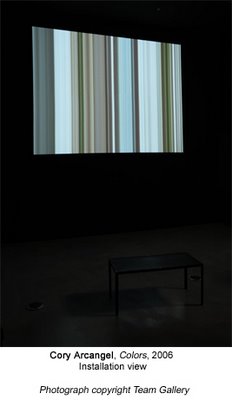View current page
48 matchs for beige:
Two fairly active threads on Cory Arcangel, Paul B. Davis, and matters BEIGE: the conversation starts here and seems to be continuing here. So far Paddy Johnson's questions from last fall--about Untitled Translation Exercise in particular--aren't being answered, although some good points have been made overall. Once again some fairly persistent commenter(s) are avoiding the issues and accusing me of personal belligerence and hostility. This rather proves my point that the discussion around BEIGE these days isn't about issues but about declaring for or against certain artists. We need to get over this.
Update: A couple of comments about UTE have been made since I posted.
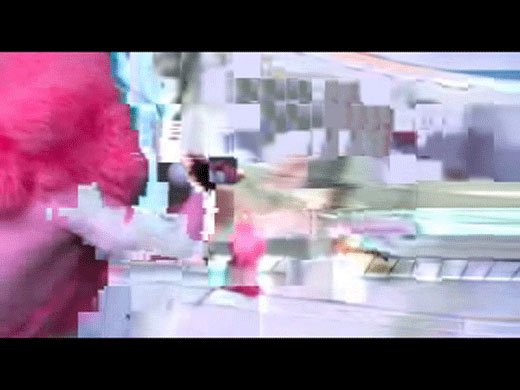
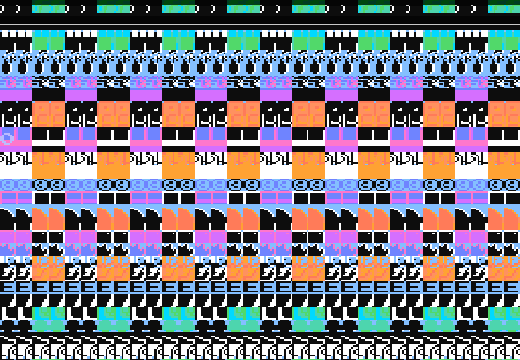
Meanwhile, in an alternate universe where more than one artist using the computer broke through to staggering international recognition, making new media people all jumpy and feeling like they had to "declare":
PAUL B. DAVIS [BEIGE]I fondly recall the turntable with the 8-Bit Construction Set LP in the front room of the old Team Gallery, crammed with other BEIGE work.
INTENTIONAL COMPUTING
Seventeen Gallery, London, 30th May – 23rd June 2007
Paul B. Davis is obsessed with computers and makes art that helps him understand how they work. He’s a founder member of the pioneering programming ensemble BEIGE along with Cory Arcangel, Joe Beuckman and Joseph Bonn.
This exhibition comprises two large projections. Five in One, 2007 is a new NES hack that takes its form from the pirate video game cartridges that first alerted Davis to the possibility of intervening with games. These ‘multicarts’ often had for or five different games on one cartridge and echoing this, Davis is presenting five different works on one machine. Fittingly these pirated works are not all by Davis’ hand, as he loots excerpts from other BEIGE collective hacks, questioning authorship in the already grey area of software as readymade. The second piece is a new video, a collaboration with the trans-media collective Paper Rad, which accentuates and aesthecises artefacts inherent in video compression formats, particularly MPEG-4 [titled Video Compression Study II, 2007]. A third work, in collaboration with Cory Arcangel, titled Fat Bits, is a triptych of monitors which presents close up images of an NHL ice hockey game, converted into imagery housed in an NES. Reminiscent of the timeless NES Ice Hockey game, these abstracted motions of brawling figures present a bacon-esque scene, groaning and grunting in a slow motion and distorted struggle.
Aesthetically Davis’ images are solid slabs of reordered, pure proto-modernist colour. With his alterations a new game, a new screen and a new surface emerges. The materiality of a hacked game cartridge, set into the instantly recognisable Nintendo console, guarantees that the recession into a purely two-dimension digital fold is never as total as it is in the work of other digital artists, the work remains an object. Further, the dizzying hyper-graphics of many related practitioners are surrendered in favour of the neat, blocky pixilation of the outdated NES operating system. This show also includes an installation featuring 8-bit Construction Set – an art/music/concept work rendered in vinyl which will be mounted on a record deck within the gallery, visitors being invited to play it out to their own satisfaction.
Quoting his influences as ranging from formalised British computing theory (Alan Turing) to the advent of widespread domestic console gaming (Mario), Davis has pioneered a truly unique strategy through a multiplicity of actions, networks and artistic creations. Davis’ practise is at once rigorous, conceptual – even nerdy, while nonetheless fully intimate with the patois, style, attitude and aesthetic of retrogressively inspired, data-bit multi-media contemporary culture, that has recently forced its way into the public consciousness.
Below is Paddy Johnson's review of Cory Arcangel's "...participatory culture" show at Team Gallery last year. While critical, it is ultimately respectful and merely expresses what many thought about the show but were too cautious to say for fear of jinxing the first non-sucky computer artist to break through to art world recognition. Including me, even though I felt the show was a step back to the "BitStreams" era. I'm bringing it up now because recent writing about the artist seems to be adopting a strangely defensive or belligerent tone--it's as if you have declare whether you're for or against him, and I think we need to get over this. This review was not reBlogged by Eyebeam or Rhizome, the main new media sites, which also seems like a partisan and slightly juvenile snub. The issues are worth discussing.
I have been spending a lot of time thinking about how to discuss New Media artist Cory Arcangel’s new exhibition, subtractions, modifications, addenda, and other recent contributions to participatory culture at Team Gallery, and it’s not the exercise in fun it usually is. Writing about my friends is great when I’ve only got compliments to bestow, but it’s another ball of wax when I leave their exhibition with a mental list of artists who have done similar work.Don’t get me wrong, subtractions, modifications, addenda, and other recent contributions to participatory culture, isn’t entirely derivative, nor is it a bad show per say, but it does inspire a number of questions, that aren’t easily resolved. Probably the strongest work in the show is Untitled Translation Exercise, a modified version of Dazed and Confused, a film by Richard Linklater, which now features the redubbed voices of Indian actors performing the screenplay in English. The original movie is a coming of age story about a group of American high schools students experiencing the anxiety, boredom, and fervor of teenage years, so Arcangel’s choice to outsource the dialogue, both heightens the viewer’s sense of what it means to be American, and reflects the development of new industries in the United States.
You’d think these ideas would be enough to stamp the piece as good and be done with it, but I can’t reconcile the feeling that the decision to outsource the film’s dialogue isn’t entirely resolved. There are simply too many loose ends at play here. What does the work gain by outsourcing labor that has already been completed? Was it necessary to make a feature length movie? Does the film’s narrative support the alteration? These questions don’t come up in Woody Allen’s similarly conceived, What’s Up Tiger Lily, a 1966 film whereby the director purchased a Japanese spy movie, removed the sound track and replaced it with his own. Clearly the two films are different, but you can’t say the approach doesn’t, at the very least, merit comparison.

The other video based works in the exhibition do not invite specific film references the way Untitled Translation Exercise does, but they do seem awfully close to work that has already been made. Arcangel’s Colors for example, extends pixels line by line in the Dennis Hopper movie by the same name to create a moving vertical pattern reminiscent of New Media artist Jason Salavon’s The Top Grossing Film of All Time 1×1. Exhibited in 2001 at the Whitney’s exhibition Bitstreams, the artist uses the average color of each frame in the movie Titanic, and arranges them in a digital c-print to follow the narrative sequence they would have appeared in. I suspect the programs each artist wrote to create their work were difficult to execute, but unlike the work of Salavon, those with even a small amount of website construction experience will be familiar with the technique of expanding pixels, and subsequently won’t find the Arcangel manipulation all that interesting. Even without this knowledge, I imagine many viewers will still be left wondering what the point of the alteration is (other than to create a moderately attractive picture).
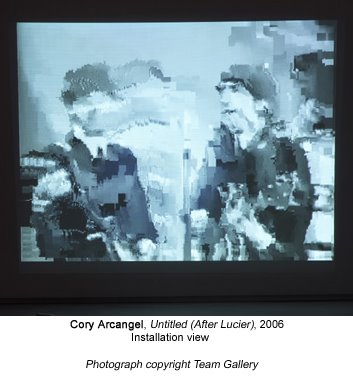
The reason these issues exist in this work, as with Untitled (After Lucier), a video loop of the Beatles on The Ed Sullivan show which compresses and loses image quality with each repetition, is that in each case, the content is subservient to the technology. And unfortunately, just as painting about painting is dull, so is tech art about tech. The thing is, Arcangel knows this, so despite the fact that some of the work in this show falls short, I have trouble believing that the exhibition is some sort of sign of things to come. Two weeks ago at Vertexlist, the artist performed pieces from his record The Bruce Springsteen ‘Born To Run’ Glockenspiel Addendum (also part of his show), and while, I can’t claim to understand why the record needed to be a remix album (the artist composed five Glockenspiel pieces for the Bruce Springsteen album Born to Run, in addition to the three Springsteen had already written, matched them to the time count of the music, and removed the original music), his performance demonstrated his usual brilliance. There was a charming awkwardness to his playing, which made the piece at once humble, moving, and strangely funny. In fact, it was so enjoyable, that the thought occurred to me that while subtractions, modifications, addenda, and other recent contributions to participatory culture, isn’t the best thing the artist has ever done, if he had thrown a performance into his show, nobody would have ever known the difference.
Correction to an earlier post, which read:
Should galleries not post documentation so people will get off their lazy butts and come to see actual work? Cory Arcangel also addresses this matter in a transcription of a recent talk he gave, but from the reverse vantage point--he describes work he's seen on the Internet to people sitting in "real space" without a computer as an audiovisual aid.A friend noted that I am *completely* wrong about this--Arcangel's text reads like a transcription but is actually anecdotal, semi-stream of consciousness writing about the internet, to be read on the internet, but where links are perversely not used. My friend found this annoyingly unhelpful but I defended it, as someone who has spent six years worrying about whether hyperlinks were broken and/or up to date--after a while you just want to say, "ah--google it yourself." It's possible I may still not be getting this text so any theories are welcome.
Update: I closed this thread but reopened it for some additional commentary that came via email.
Update 2: And then closed it again due to spam.
Aron Namenwirth did a studio visit today, and took some nice photos, which are here.
The issue came up about people in the art world saying, regarding exhibits, "Yeah, I saw the show, I saw it on the Internet." Should galleries not post documentation so people will get off their lazy butts and come to see actual work? Cory Arcangel also addresses this matter in a transcription of a recent talk he gave, but from the reverse vantage point--he describes work he's seen on the Internet to people sitting in "real space" without a computer as an audiovisual aid. [Update: a friend noted that I am completely wrong about this--it reads like a transcription but appears to be some kind of stream of consciousness typing about the internet, to be read on the internet, but where no links are used.]
I'd been putting off the list of "art YouTubes" he and Hanne Mugaas recently published due to general leeriness of "art about art" and it feeling too much like homework. Certainly one could live without ever seeing the Italian Vanessa Beecroft interview again, but there are bad boy surprises lurking in the roster, too, such as this tribute to Barbara Kruger.
Good, clearly laid out survey of the chip music scene by Marcin Ramocki, on the vertexList blog. Originally appeared in Yard magazine, with added photos and links. Sample quote: "Many analogue-heads don’t understand the technical concept of making music on Game Boy and confuse it with sampling video-game tunes. This couldn’t be less accurate. Working with a Game Boy tracker is a very complex composition process; perhaps much more demanding because of its 'bare bones' sound library and minimal interfacing."
One correction to Ramocki's post should be made: the second of the two "pioneers of chiptune music" he mentions should properly be identified as the BEIGE collective, consisting of Cory Arcangel, Joe Beuckman, Joe Bonn, and Paul B. Davis. See my post on them from '02.
More: Ramocki's post has been updated with an email from Paul B. Davis giving some detail about who did what on the 8 Bit Construction Set record. This is fascinating stuff for those of us who had our worlds rocked by that disc.
Still more: Davis' update, which seems to be undergoing some revision over on the vertexList blog, says that the 8 Bit Construction Set was Paul's band and
Even more thoughts: while I do find the "who did what" breakdown fascinating, I'm going to continue to live with my illusions that this was a group effort, particularly since the LP did an excellent job of mystifying the consumer and not parsing credit. Cory Arcangel has been good over the years about describing his projects as Beige projects. It's not his fault that art world movers and shakers seem incapable of acknowledging communal authorship. The "Great Men" theory of art history has brought the world so much pain. Whether or not it is "Paul's band"--and I'd like to read some other band members' thoughts on that before laying down some journalistic edict--they all deserve props for an epoch-making work.
Final (?) update. Davis says the following in the comments. Since no one else has come forward with any disagreement I extend him belated and heartfelt congrats for his role in a brilliant record:
hiya tom, while i think you misinterpreted my post a bit and don't need an illusion about the group effort on the record, i'll go to my grave--or rather our deitch enterprises tv/vh1 8bit construction set behind the music special--saying its my band cos i write the tunes [and im a bit proud of them].Davis explained in an email, regarding the earlier wording of the vertexList update: "i wrote the songs myself on the 8bit record [dollars and saucemaster] and as a result cory and i discussed 8bitcs as being 'my band,' but it's definitely not 'my self titled l/p' but 'our self titled l/p' because the record had contributions from everyone." In the email Davis also mentions that he designed the LP cover, which had the "cracker" aesthetic down pat.
it's not normally an issue, one of BEIGE's purposes was to avoid these sorts of things and i take the steady art world goofs about cor's individual role in the 8bitcs project and Nintendo stuff with a grain of salt - it's none of our fault that people don't do their research. it's just that I got forwarded two really bad ones in one day [marcin's and francesco spaminato's essay in the "sound & vision" book] and snapped.
btw, i'd like to announce here that a box of mint condition, 8bit construction set records has recently been found [!] in my parent's basement and will be made available to discriminating art-buyers [sic]. seriously if ppl want one drop me an email paul AT beigerecords DOT com, i dont know how yet cos my pops isn't about to mail them out, but at some point i'll sort it.
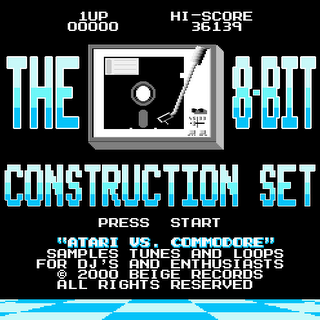
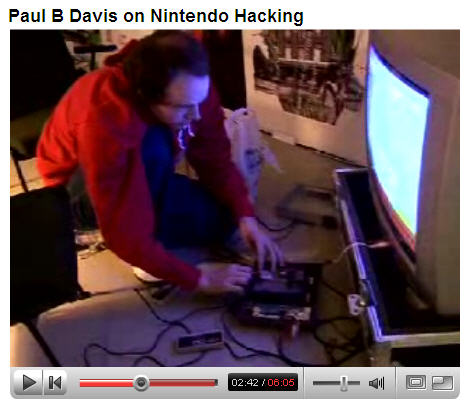
YouTube: "Produced by Hit 'n' Run [for Dutch television], this interview took place with Paul B. Davis from the BEIGE collective at the 35th International Film Festival Rotterdam. Paul exhibited a piece at the exhibition 'Satellite of Love' produced by Exploding Television. Here he talks about his Nintendo Cartridge Hacking."
Davis' delivery is very dry and funny in this video, and he has some great things to say. He and fellow artist Cory Arcangel, through their work with the BEIGE collective, have both been active proponents of busting open game cartridges and reprogramming the chips (though perhaps in a less aggressively activist way today than a few years ago--but that's another post). While gaygamer.net calls Mary Flanagan the "secret heart" of the movie 8 BIT, I don't really agree with that. (As mentioned earlier, Kristin Lucas's work would have been a catchier example in the film to show the psychological effects of life in a high-speed technological world--her late '90s videos incorporating game and sci-fi tropes are at once disturbing, aesthetically engaging, "lo fi," and presaged many themes of what might now be called the 8 BIT movement.)
No, if the movie has a secret heart, it's why Arcangel and Davis, who used the phrase "8 Bit" in an LP title five years ago and are sort of the poster children for the current scene, started hacking Nintendo cartridges in the first place. Davis was always the more political of the pair in how he speaks about it, but he makes an interesting point in this YouTube vid: that untapped aesthetic potential exists in everyday gear that is meant to be inaccessible to us. As he describes it, the "cheapest, highest quality audio and video generation system you could get" is locked up in a proprietary system that mostly sits in your closet. Although its hardware and software constitute a complete or "general purpose" computer, it only does one thing, which is play this one particular brand of game.
This is what I would call the "ecological" argument--a wry complaint addressed to the consumerist waste that is the bedrock of our capitalist system and represents a condition that simply will not go on forever, as resources dry up and the planet turns into a sewer. To some extent the 8-bit scene gives a glimpse of artists we will have after the Fall: patterned on archetypes like Gilligan's Island's Professor or Escape from New York's Brain, they will squeeze "energy dependent culture" out of a diminishing stock of manufactured products. Yet the BEIGE crew is doing it now, while we're still awash in plentiful, working consumer electronics. Their suggestion that "anyone can hack cartridges" also recalls Robert Pirsig's '70s self help book Zen and the Art of Motorcycle Maintenance, which argued for people taking back some control in their technologically dependent lives. Of course, the BEIGE work is goofy and fun, too--it's not as Earth First!-y or New Age as I'm making it sound. Here is an excerpt from an early manifesto, written by Davis; it would have been nice to hear more of this in 8 BIT:
Bereft of a veneer, interaction with such complicated machinery requires a significant amount of technological knowledge and awareness. In this spirit, "Fat Bits" represents a step towards what Cory and I describe as "Post-Data". We create computer art which is aesthetically aware of both its own identity and the underlying process which supports it - that is to say it recognizes the fundamental prototype of the "computer", and not the "software", as the tool and medium. The content for "Fat Bits", video of a NHL hockey fight, was chosen because the close-up nature of its imagery makes for convenient replication on low-resolution systems such as the Nintendo Entertainment System. The use of the Nintendo Entertainment System is itself important because it, firstly, signifies an artistic "re-licensing" of proprietary corporate technology and, secondly, refutes Nintendo's forced obsolescence profit structure which defines it as "outdated" (the Nintendo Entertainment System was introduced to the US home video game market in 1986). Our primary foundation of Post Data is then this: the conscious corruption of data, the releasing of bits from their imprisonment within the restrictive, limiting boundaries of corporate software applications, and the exploitation of the extreme complexity of computer systems paired with the extreme intentionality of artist(s) who seek to engage the computing process at a fundamental level.
Notes on the 8 BIT premiere at MOMA, Oct 7 (work in process)
--the 420-seat theatre was 5 seats shy of being completely full, I was told.
--My description of Game Boy music as "that tuneless stuff Malcolm McLaren likes" and Nullsleep's vituperative response from a live stage got a laugh. I'm resigned to my role as "the heel," as it is called in professional wrestling. Post-screening comments about that "battle" were interesting: a media critic who attended called it a "mods vs rockers moment" and a higher-up in a media arts non-profit said to me: "I was surprised--I thought you supported our music." I do, most of it--I guess this person hasn't been reading my blog lately.
--The movie favors a sociological, narrative, theoretical style of art. A different 8 BIT would tilt more to the crazy, pointless, Dionysian (but not wholly uncritical) side, represented by Paper Rad, who use game imagery and techniques extensively in their online and offline cartooniverse. Kristin Lucas's pioneering game-based videos emphasizing (Modernity-damaged, personal) psychology over Marxist socio-crit could also be included.
--Rumor has it JODI footage will be inserted--I love them, but they were established Internet-dismantlers before they became game dismantlers (correct me if I'm wrong). They would be the logical centerpiece to 8 BIT: The Return. 8 BIT already borders on long--not sure it can handle much more run time.
--If 8 BIT as currently constituted seems balanced (and it does), it is because the music clips and the montages of game "trash" supply the ebullient, anarchic counterpoint to institutional critique.
--the audience laughed at the funny parts and everyone seemed into it, including many who hadn't encountered Super Mario Clouds before.
--the movie is driven by excellent music and, as mentioned, relentlessly tasty videogame imagery--these are the glue binding together what is otherwise a series of (intermittently great) talking head interviews.
--Music-wise, Bodenstandig 2000 is a perfect mix of gritty chip tone techno-rave, Nitzer Ebb white b-boy rapping/chanting, and Laibach-ian Euro-gloom: they're accomplished "major label" musicians keeping it real with gear anyone can own. Snippets of other outstanding performances keep the film humming.
--the other thing that drives the movie is, once again, a busy visual sensibility centered on games. This has less to do with the individual artists featured than the producers' in-depth research and use of found clips that show a real love for the idiosyncrasies and poetry of games. This unified visual style supplies the feeling of an art movement--even when the artists actually have quite different backgrounds and intents. (I personally see the DIY, WTF work of Bodenstandig and the BEIGE crew as being opposed to the overdetermined, overproduced global capitalist apologetics of, say, John Klima.) Producer/Co-director/Director of Photography Justin Strawhand deserves special mention for this unifying use of images and clips mined from the net and creatively montaged. (Not to slight the contributions of Director and original concept-er Marcin Ramocki)
MOMA 8 BIT page (there's a second screening on Wednesday, Oct 11)
8 BIT website
More on the movie 8 BIT, opening this weekend at MOMA. The interview below is cobbled together from email questions Paddy Johnson sent me in connection with her Reeler article, and my responses:
PJ: Do you see yourself, and does the movie portray you as an artist working within the genre who is a counterpoint to a generation who has grown up with these influences? I would imagine that from this perspective your position as an artist and a critic would be key.
TM: My interview footage is used a number of times in the film. It's the wonky side of me that you see on my blog, analyzing, historicizing, and kibbitzing about others' work, mostly. (Sure to win me more friends!)
The movie title "8 BIT"--referring to a type of computer memory used in older machines--applies to art and music made with videogames, which the movie focuses on, but also the "lo-fi" tendency in new media art.
At one point in the film, Cory Arcangel talks about the different types of sounds that come out of different '80s computers. He and and the BEIGE crew used those sounds to make classic "electro" tunes that were not "videogame art" per se, but music proactively using the limitations of that old gear.
Working at the low end of computing is a kind of resistance to, or critique of, the high end--the ubiquitous domain of company-employed, non-artist experts.
The DIY, hacker, guerrilla mindset is a constant theme in the movie--the topic is bigger than videogames. One thing I like about the film is it casts its net wider than just a small scene.
PJ: One of the threads that runs through the movie is that because the medium is so new, we are still figuring out how to work with it. You briefly describe a progression of games pointing out that at each point along this time line artists could respond to the technology, but we haven't had enough time to deal with it all. This is very true, and the issue is compounded, I think, by the fact that technology changes so quickly that you can't respond to all of it. It seems to me one of the challenges new media faces is figuring out how to create work that has permanence in a medium that is constantly changing. Do you think this is happening?
TM: New media artists are fairly attuned to issues of what's gained or lost in the constant process of "updating" software and hardware. A lot of the in-jokes deal with the outmoded (Pong, MacPaint) or not-yet-moded (e.g., "vaporware"). The problem is arriving at a consensus of what's good and bad in the *art* (as opposed to just the tech), and then how to present this to the broader art world. That's where blogs are useful--these issues can be hashed out. I feel like I've found a peer group through blogging and the Net, which is overall more open and verbal than what I found with my peers in the art world. Films like 8 BIT are also helpful in defining the values of a "scene." What should be in the movie? What shouldn't? I've often said that since artists are not "joiners" by nature (i.e., they are self-absorbed holy terrors), when two or more of them agree on something it's usually significant. Then the rest of the world has to catch up.
PJ: Well, from that standpoint, I think this is an important movie for New Media, because it will help people understand how artists come to make the work they are making. For instance one of the commonalities among almost all of the artists was their interest in creating limitations and then working within these perimeters. Is this something that you feel is a result of the bias of the medium (in other words, programming requires a certain kind of thought process, so this desire stems from an interest in the way the medium works in the first place) or a larger cultural construct? Does this way of working influence your studio practice in any way?
TM: As for the larger cultural construct, yes, as I touched on earlier it's a kind of resistance to the more obnoxious principles of Modernity--planned obsolescence, buying new gear to keep up with the neighbors, proprietary software that controls you rather than the reverse--while still working with materials and processes that have something to do with the era you live in.
On a practice level, let's go back to the example of the '80s computer sounds the BEIGE crew's 8-Bit Construction Set record. One reason for using the older Atari and Commodore computers is that the sounds are excellent--gravelly, squelchy, very distinctively "low-res." Newer gear "improved" and got rid of some of those.
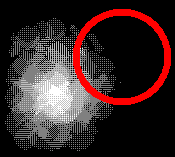 I use an older version of the Windows MSPaint software to make artwork and animated GIFs. Partly I'm being "office ironic," but the program had a particular way of doing pixelated crosshatching that was "improved" in subsequent versions and lost. I don't use the program because it's older, but because it's actually better. These sound like "formal" issues, but a particular look or sound can be very important to an artist's work.
I use an older version of the Windows MSPaint software to make artwork and animated GIFs. Partly I'm being "office ironic," but the program had a particular way of doing pixelated crosshatching that was "improved" in subsequent versions and lost. I don't use the program because it's older, but because it's actually better. These sound like "formal" issues, but a particular look or sound can be very important to an artist's work. PJ: In the movie you talk about Game Boy music being tuneless, which of course upset a bunch of Game Boy musicians. Immediately following angry musician footage is a clip allowing you explaining that point further. But this clip consists merely of "What I meant by that is it's not interesting melodically." I thought it was an interesting editing choice, as I am guessing you had more to say on the point than this, it probably connected these thoughts on Atari and Commodore computers. Is this the case?
TM: Game Boy music was declared the "next big thing" by Malcolm McLaren, promoter of the Sex Pistols, a few years back. Just to be clear, because it may be a little confusing in the film, my comments didn't apply to all "8-Bit" style music or "chiptunes." Just the Game Boy subset of it--which gets its own section in the 8 BIT movie.
The Game Boy is more limited as a music-making device than say, the Commodore 64 chip, which has analog filters, ADSR (sound envelope) shapers, etc. It's a 4-bit, 4-channel sound chip, and almost all the music is made on it is done with the interface designed by the Swedish musician/hacker Role Model. The music's cute, but too much of it sounds like...a Game Boy, or worse, somebody randomly pecking around the keyboard. (Bit Shifter is, I'm told, the Segovia of Game Boy music, but I keep missing his performances.)
By contrast, what the BEIGE crew and Tree Wave do with the Commodore and the Atari is rich and complex--hacking the sound chips (or not) to make music with a greater range and a fuller sound in a performance context. Bodenstandig 2000 also shows the extremes of what can be done with chips and tracker interfaces--really nasty drum and bass, among other things.
Cassie - "Me & U" [YouTube]
The "U" in the case of this video is Cassie's image in the mirror, for whom she sings, mugs winsomely, strips off her shirt, and pours POWERAde on herself in this immortal tribute to narcissism.
I post it as a basis for comparison to Brains' grime-y remix of the same tune (which you can hear on his MySpace page). He slows down the tempo to near-Romilar level and adds drum and bass burbles, videogame stings and a general all purpose bending of time and space. I envy his production skills and the full, liquid sound he gets--blowing out the car speakers bass notwithstanding. The hyperactive annotations to the Cassie lyrics are by London's m.c. Scorcher. Check it out.
More Brains here.
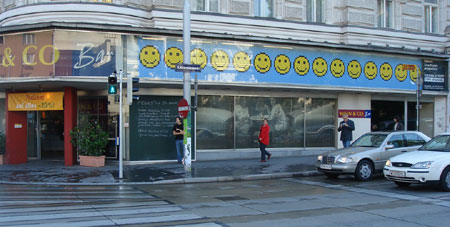
Cory Arcangel: "In collaboration with Galerie Lisa Ruyter and the museum in progress, I have placed a horizontal rule of gif smilies onto the Wein & Co building in Vienna..."
From the museum in progress website: "Cory Arcangel's stripe is based on 'horizontal rules,' horizontal lines of images which were common for early webpage designers to divide their webpages horizontally."
That's the front story and the back story. How many people walking down the street in Vienna will recognize that line of smileys as kitsch from the early vernacular web, to use Olia Lialina's phrase? I don't care--I like the utter banality of this piece whatever the viewer gets from it. I'm guessing it's invisible to the passerby, and there's something really beautiful about that. On the other hand, maybe it has a slightly alien quality that makes it pop (that's a verb) out there on the street. That's the curse of reacting to work from secondhand sources: we just don't know.
Update: For the Lisa Ruyter referred to in this post see Francis Ruyter.
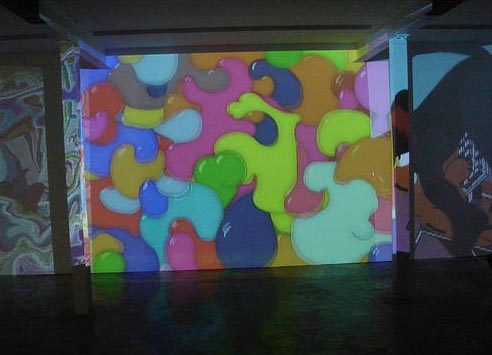
Continuing on the topic of "showing new media art in the gallery": Pierre took the terrific installation shot above of Takeshi Murata's work (the image is on Pierre's flickr page with commentary here), at Vilma Gold Gallery in London. The exhibit was "Take it to the Net," curated by Hanne Mugaas, which included Murata, Michael Bell-Smith, Seth Price, Paper Rad, Paul Davis (Beige), Thomas Barbey, and Jean Baptiste Bayle. I'm curious to know more about this piece. Would I like it less in person? More? What is its "net art equivalent"? Does it have one?
Update: More installation photos of "Take it to the Net" here.
Cory Arcangel has created a web page with Kurt Cobain's suicide note that, when refreshed, pulls up different sets of Google Ads based on "keywords" in the letter. Pretty droll, and about says it all about our ad-annotated culture. I should say, so-called suicide note because, this being the first time I've read it, it sure didn't sound like he was planning to kill himself. More like, explaining why he was going to stop touring. As Paul notes, there is a conspiracy theory about the "suicide" that this note certain lends credence to.
More YouTube:
Haruomi Hosono, "Xevious BGM" (Video Game Music--disco version). I mentioned Hosono when I first wrote about Cory and BEIGE back in aught-2.
Naruto AMV (String Quartet). Found this looking for video mashup material to go with my string quartet piece. I have to do a public performance of my music in a few weeks and think I'd rather have videos playing than stand there picking my nose while the CD runs. I'm thinking about further cutting up this one, that got me thinking about Rose Hobart, etc...
GIF Shows
 The solo show I'm doing next month is titled "Room Sized Animated GIFs." The ArtCal listing is here (thanks to ArtCal--the listing is in RSS now will go "live" a week before the opening). The choice to use, in the title, a banal everyday computer "file extension" (.GIF) that hasn't quite risen to the level of a household word was deliberate. The point is not to be tech-elitist but rather that there is nothing more un-elite than an animated GIF, your grandmother has several of them on her homepage, but the word "GIF" is nevertheless seldom bandied about in the medieval, still-painting-centric artworld.
The solo show I'm doing next month is titled "Room Sized Animated GIFs." The ArtCal listing is here (thanks to ArtCal--the listing is in RSS now will go "live" a week before the opening). The choice to use, in the title, a banal everyday computer "file extension" (.GIF) that hasn't quite risen to the level of a household word was deliberate. The point is not to be tech-elitist but rather that there is nothing more un-elite than an animated GIF, your grandmother has several of them on her homepage, but the word "GIF" is nevertheless seldom bandied about in the medieval, still-painting-centric artworld. Another show I'm in taking the humble GIF as its theme is described on Marisa Olson's blog:
Hi, there. I've unashamedly followed the masses to Myspace, and there I've erected a page for an upcoming exhibit I'm curating. Please check it out and become our friend:Why GIFs? They're a relatively "open source" way to get ideas, in the form of moving images, out to broad audience. They are low or no cost to make, consume very little bandwidth, no one has to buy or download a proprietary player to play them. They have their own special charm, minimal in the way garage rock is minimal. Scaling them up to room size, showing them on TV screens as opposed to computer monitors, exhibiting individual frames in a grid, are ways to inject this aesthetic into physical space, which has its own demands, limitations, and pleasures.
http://www.myspace.com/gifshow
The show is called The Gif Show (I briefly considered Meet the Giffords, Meet the Giffordz, Gif Starz, and Choosy Moms Choose GIF). It opens May 3, at San Francisco's beloved RX Gallery, and is co-presented by Rhizome. The artists are Cory Arcangel, Peter Baldes, Michael Bell-Smith, Jimpunk, Olia Lialina, Abe Linkoln, Guthrie Lonergan, Lovid, Tom Moody, Paper Rad, Paul Slocum, and Matt Smear (aka 893/umeancompetitor). Everyone's showing GIFs, and some are also showing videos, works on paper, sound, and other cool related stuff. Together, their work shows the diversity of forms to be found in GIFs, and many of them comment on the broader social life of these image files.
Hence the Myspace page... GIFs grow, breed, and comingle sparklingly on Myspace. Please come be our neighbor, there, and help us spread the word about the show. (More curatorial & opening party details to come, here, in a bit.)
posted by Marisa S. Olson at 12:01
Paddy Johnson interviews Cory Arcangel:
FANZINE: In fact it was a friend, Yael Kanarek, that organized your first talk in 2001 at Eyebeam. I remember this talk because you said some rather nasty things about Flash––the crux of your argument being that you should understand how a program is built if you are going to use it, and that Flash makes everything look the same. I saw your lecture at Columbia University in 2004 online, where you appear to have changed your opinion a little. Though you don't speak specifically about Flash, you do mention that you now believe that as long as you understand software imposes an aesthetic then it is fine to work with it. What was it that made you change your mind?
CORY ARCANGEL: Well in 2001, I was still a punk basically, and just thought it was my way or the highway. This was inherited from the BEIGE days, where we kinda rolled as a computer gang, and pretty much hated anything that wasn’t exactly like what we were doing. But I guess as we grew older we started seeing all this work that we loved that wasn’t necessarily 100% craft aware. In fact it was the opposite. I mean look at the Internet? How many amazing crappy Flash animations are there? And those are amazing!! Also, I began to see bad Photoshop art where the artist knew it was bad and was therefore OK. So I needed to find a way to accommodate this perspective.....otherwise I would be ruling out a lot of great self aware media art that is made these days. I had to have a way to deal with that in my own set of rules...
Recommended: Guthrie Lonergan's 9 Short Music Videos. Reminiscent of BEIGE's cheesy blue (green?) screen vids, each is built around some corporate sound (ringtone, Microsoft boot-up noise, DVD intro) that craps up our daily lives. Also good: Bricks Video. And a lecture "Surfing the Internet in Public." Be sure to check out Ian Haig's "Men of the Internet" while you're there. Really need to spend more time surfing. So many gems, so little time...
2005 Internet Top Ten: Special Blogosphere Edition.
Originally posted on Michael Bell-Smith's and Cory Arcangel's Year in the Internet 2005 page. Already started revising it (see below).
SCREENFULL. This blog is now an archived project but what a great run it had. Audiovisual graffiti, deconstruction as Xtreme Sports, internet addiction as a generative principle.
RIP del.ico.us? 2005 saw this link community's rapid rise to stardom and immediate fall into the sweaty embrace of Yahoo! Will the art/geek spirit survive?
Represent or die. Lots of great quirky and f-ed up videos: the flagship del.icio.us channel (for DTV) hopefully will not be turned by Yahoo! into internet MTV, with Quicktime clips of reality shows and beach contests.
Paper Rad Info. Their blog. Prediction: because it's very easy to update it could eclipse their main page. Mine sort of did.
jenghizkhan (John Parker) live at The Front Room. Not a blog; just wanted to mention it. Sub-Troggs, Sub-Stooges fuzzbox-grungy Monomachine and circuit-bent Casio performance clocks in at 33 minutes; chatty audience tries to see if it can make more noise.
Steve Gilliard: the most razor-tongued sunny optimist on the Net. Indispensable political commentary.
WFMU's Beware of the Blog. NY area cult radio station's in-depth music (and everything else) coverage thrives in blog form. One of my favorite past FMU djs returns with a fine conversational blog style: Rise, William Berger, rise.
Rhizome.org. Another welcome addition to the (re)blog world--hopefully they'll start archiving front page content and add comments in the new year.
Other great blogs that have launched or gone into high gear in the last year: Cory Arcangel, Paul Slocum, Michael Bell-Smith.
Flag on the Moon. Blog of Jack Masters, of castlezzt fame. The post specifically linked to, "1/30th of my pictures directory, in chronological order," has been
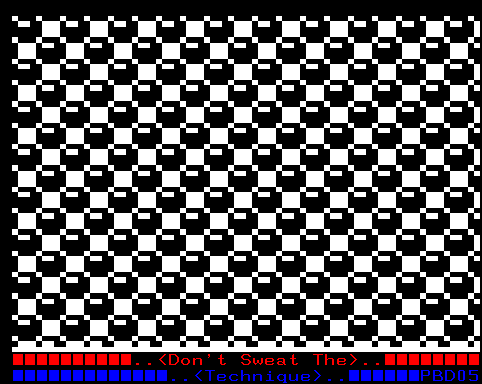
An image made with the CebraText teletext editor for eventual transmission on the Boob Tube. As mentioned below, Emma Davidson (Lektrolab) and Paul B. Davis (Lektrolab/BEIGE) are doing a Teletext project that will run on Dutch TV later this month as part of ambientTV.net. Their Teletext TV station is called Microtel, and they are calling for submissions to create simple text and graphics messages. You can download the CebraText program (Windows only) to create the Teletext files and then email the files to Davis and Davidson for TV reformatting. The above artwork, by Davis, is an example; the tutorials on the Microtel site make the process seem pretty painless. I say that because I haven't tried it yet. The interest in near-obsolete media and the reincarnation of old programs in an open source environment I find pretty fascinating; the aesthetics of it are what drew me to the BEIGE project back in the day ('02).
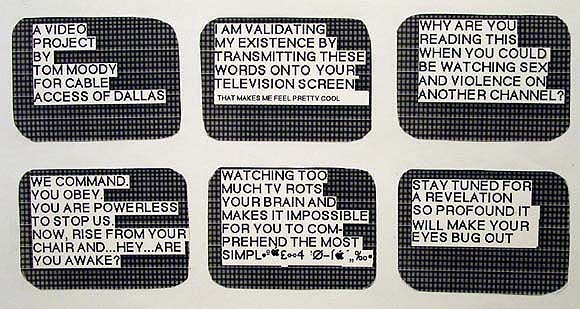
Above is a proposal page for a project I did around 1990 for Dallas Public Access Cable. Messages 2-6 above were translated into "teletext" (block capitals on blue screens) and aired individually at random times of the day. I made this crude prototype using MacPaint. Clearly, as text-based art the piece owes more to Harvey Kurtzman of Mad than Lawrence Weiner of Dia. Never saw these live because I didn't have cable but remember one anecdote from their run: Due to a technical glitch the "WE COMMAND. YOU OBEY..." screen accidentally ran on an African American affairs channel and the station got a lot of angry complaints. What, black people don't want authoritarian messages coming from their TVs? Seriously, sorry that happened but it was kind of an anti-authoritarian (or a-authoritarian) message.
I was reminded of this because Emma Davidson (Lektrolab) and Paul B. Davis (Lektrolab/BEIGE) are doing a Teletext project that will run on Dutch TV later this month as part of ambientTV.net. Their Teletext TV station is called Microtel, and they are calling for submissions to create simple text and graphics messages. If you saw the Bodenstandig 2000 show at Deitch you saw some of drx's girlie/sex ads done in this format and they looked great--very low res and cheesy. You have to download a program (Windows only) to create the Teletext files and then email the files to Paul and Emma for reformatting.
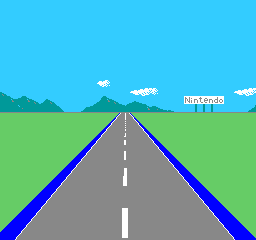
Interesting factoid I just learned: Cory Arcangel, whose hacked Nintendo cartridge piece Japanese Driving Game is depicted in the GIF above, is a relative of Pop artist Allan D'Arcangelo. Not sure the exact kinship--a cousin, but no one in the family's exactly sure how many steps removed. D'Arcangelo passed away in the '90s (and since we're talking about a distant cousin, this isn't a story of art world dynasty building, much as that might disappoint the dish-minded); some images via google are below. A frequent theme of D'Arcangelo's was road signs and American auto culture. The affinity between his art and the above piece of Arcangel's--which subtracted the cars from an '80s video game leaving the highway, signage, and surrounding landscape--is amusing. D'Arcangelo isn't as well known as Lichtenstein or Warhol, but I've always liked his work. He's one of those "impure Pop" artists, like John Wesley, whose personal style usually peeks out from behind the genre's bland corporate facade.
Update: According to family members Allan is Cory's great uncle.
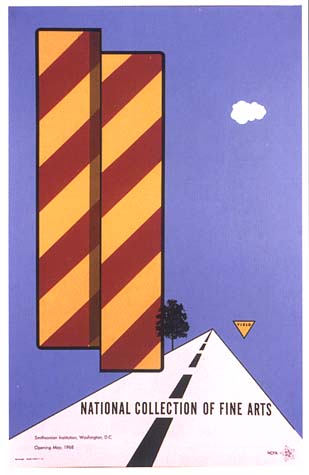

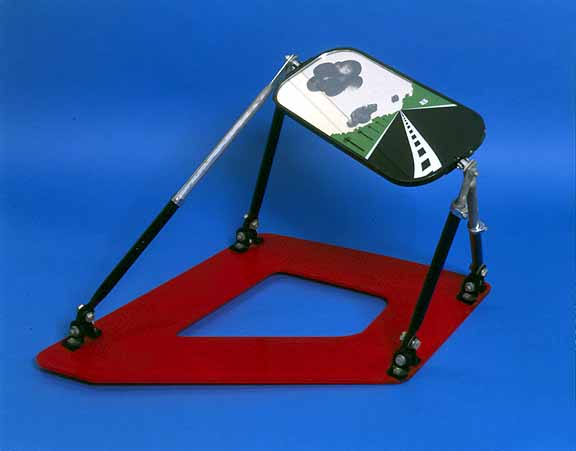
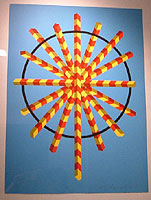

Cory Arcangel did an interview with me, published today at Rhizome.org [dead link - see below]. Thanks to him for the good back-and-forth, once I got my rather long-winded biographical reminiscing out of the way, and Marisa Olson for her editing. (Update: Marisa just reposted the lead-in to the interview--newsGRIST's reblogging of Rhizome's original post.)*
It was great to talk about music with Cory, whose work I really like. The 8-Bit Construction Set LP--which he made with the BEIGE crew--still gets props, most recently in an article in Wired. Also "Rudy Tardy and the Slowes," his solo music that I posted here a while back, continues to be listened and linked to, just this month by an Italian site called neural.it. We also talked about visual art--Chris Ashley found a good excerpt that I will probably post as a teaser; see the comments for now. In fact, I'll probably end up putting up goodly chunks of the interview here as I continue to have second thoughts and/or run out of new things to say.
At the end of the interview we discussed what it means for an artist to be "all over the place," i. e., not just sitting in the studio turning out objects in that same signature style. I gave the best answer I could--it's tough. I understand the benefits of that kind of forced discipline, and go in and out of periods of Tim Hawkinson-like focus myself, but I hate that it's the only measure of commitment or worth as an artist. One hope I had in starting the blog was that the various diverse activities documented here could be seen as feeding into some kind of overall artistic sensibility. But for all the lip service paid to the idea of cross-disciplinary practice by curators, etc., it's still viewed with skepticism. In the art world's collective unconscious, the prime model is still a romantic primitive like Albert Pinkham Ryder, painting all day and sleeping on the streets at night in a rolled up carpet. And doing nothing else.
reposted with more verbiage...and ranting
Update: New Link to Cory's interview with me.
*Update 2: Marisa Olson's lead-in is now at http://rhizome.org/editorial/2005/oct/31/tom-moody-chats-w-cory-arcangel/
Made it to the last night of Bent 2005, the circuit bending festival, at the Tank, located on a "soon-to-be-bulldozed part of far West 42nd Street," as the Washington Post describes it. Downstairs people were sitting at benches with soldering guns disassembling toys and appliances, rewiring them to make interesting electro-gnarly sounds; upstairs people were performing using such instruments. The Post article about the festival is here; an excerpt discussing a previous night's performances gives you the flavor:
None of these people is playing songs, in the sense that a song has a chorus and lyrics, a beginning, middle and end. For the most part, the performers just make noise for about 10 minutes, then the noise subsides and when they say "thank you," you know the song is over. The pleasure for performer and fan alike comes from the textures of the noise, the idea of it as a landscape that has never been experienced before. It's all about sonic novelty. You get the sense, too, that these circuit benders just like to freak people out. T-Bone, for example, wears braids, which give her the look of a schoolgirl, until you notice the top of her head, which is shaved and vividly tattooed, like a Technicolor yarmulke. One can only think of her parents.Note to the WaPo writer: Dude, you're obviously interested in this subject or you wouldn't have spent the time writing and researching it to the degree you did; you definitely took it beyond a "mere assignment." So why the condescending tone throughout your article? Is it to satisy your editors? Are you reaching out to some perceived middlebrow reading audience that you feel wouldn't like this music and that you have to apologize in advance to? Get a blog, you can be more honest. (And I can't believe you called Texas Instruments to ask the PR person if the company knew Speak and Spells were being bent. What a journo-nerd. And the performers don't generally say "Thank you," they just stop. )
Back to the festival. At 5:00 pm Paul B. Davis of BEIGE/8-Bit Construction Set gave a Nintendo-hacking workshop. In contrast to fellow BEIGE-r Cory Arcangel's lectures on this subject, which are generally laff riots, Davis's was calm and droll, but similarly informative and persuasive on the hacking principals underlying the dismantling of silly games from people's youths. He makes a distinction between general purpose computers (like the one you're reading this on) and special purpose ones (like a pocket calculator) and points out that the old game cartridges are the former, and thus can do the same kinds, or categories, of things a sleek laptop can do--it's just a matter of accessing and reprogramming them. Opening up a Nintendo cartridge and burning new data to it is a way to gain access to a device brimming with art and music making potential, albeit on the low res end of the spectrum. The age or nostalgic appeal of the machinery is interesting but largely irrelevant.
Davis came back around midnight and did a DJ set interspersed with surprisingly substantial ringtones played on his Ericsson phone through the Tank PA. Cellular audio has noticeably improved from the early bleepy stage--if improved is really the right word considering most of the material is still cheesy pop songs. The vinyl set featured electro, Grime (a successor to 2-step garage in the London club scene), and Funk Carioca, which is new to me but quite amazing. Here's a description I found googling:
Funk Carioca (Rio funk) is the product of Brazil's favelas parties and fuels the night-long bailes that form the nocturnal soundtrack of Rio's hills. Funk Carioca combines street smarts with popping dirty electro beats and the intensity of DIY techno topped with some crude lyrical rhymes resulting in an irresistible cocktail that grabs you by the hips and never lets go.More on the Bent Festival, including photos, possibly, soon.
Edited slightly for coherency, accuracy, tact, etc.
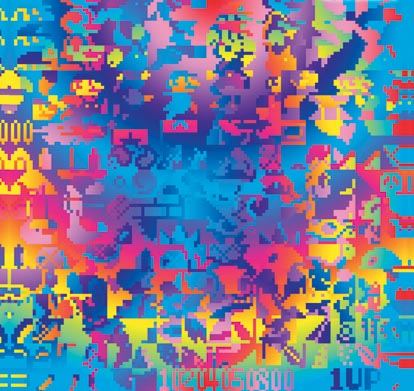
The previous post on the Arcangel + Paper Rad Super Mario Movie has been updated with some background info and technical detail. Above is the poster, compressed down to 66KB and stripped of the exhibit info and Deitch logo. This Flash-flavored image is more Paper Rad doing Beige, while the movie is more Beige doing Paper Rad. (Nerdy fan parsing.)
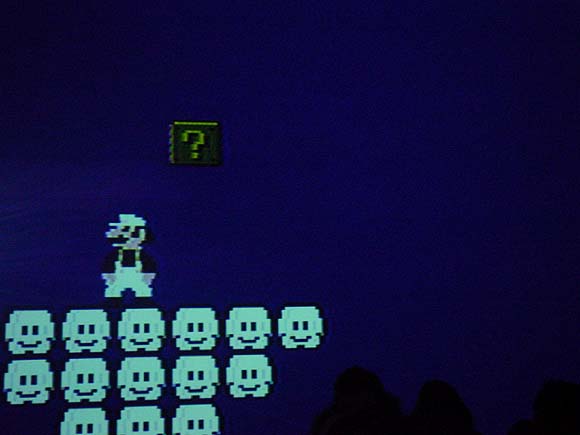
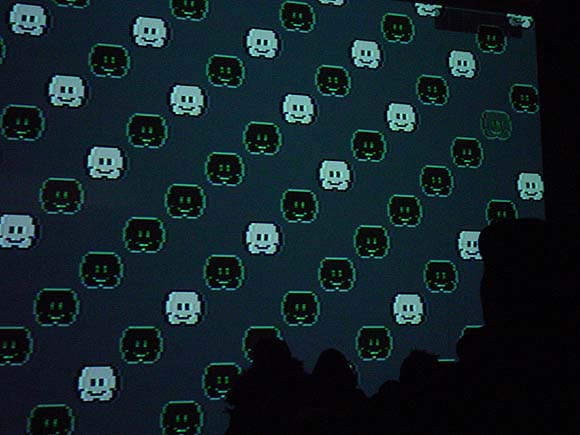
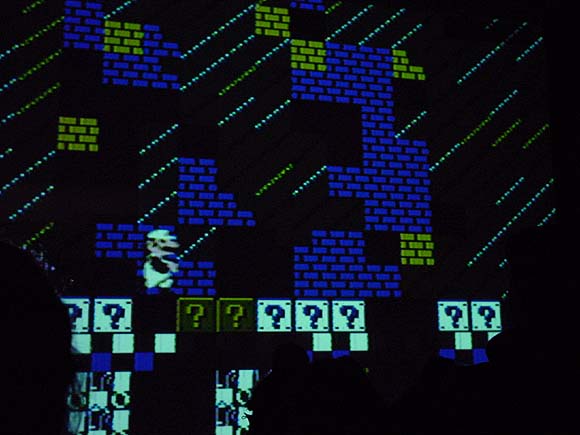
Above: bootleg over-the-crowd shots of Super Mario Movie, a wall-projected, altered Nintendo cartridge by Cory Arcangel and Paper Rad, tonight, Jan. 15, at Jeffrey Deitch. The image was impressively huge (16+ feet from floor to ceiling?) and the sound sublimely 8-bit-raspy. The plot: Mario's cartridge universe starts to break down because it's "been in a closet for 20 years." A blue creature takes him on a spiritual voyage via magic pixel carpet (the Paper Rad influence) culminating in a "rave" featuring some tasty allover patterns and intense gatling gun electro--I think it was right after the happy-hardcore smileys above, at any rate the screen text announced "This is the rave." Excellent work; hundreds of person hours of poking in sprites on the hacked cartridge paid off. It was nice to see the "twice the psychedelia" concept realized on such a large scale. (As discussed in this earlier post [scroll down], by generating the blinking geometric grids at the microchip level, as opposed to plugging values in some off-the-shelf lightshow program, Arcangel takes advantage of the cartridge's ability to sync up with the tv raster at a 60 lines per second refresh rate, which is twice as fast as video [32 lines per second]. Hence, twice the psychedelia.) As explained in a "making of" video at Deitch, the Paper Rad crew submitted drawings and animation routines that Arcangel then laboriously converted to code and burned on the cartridge's chip, but his artistic hand is prominent in it as well: the collaboration successfully melds the BEIGE and Rad sensibilities. (The source code is posted on the four walls of the gallery's front room for the geek-minded.)
Below, a "deleted frame" that came to me via the miracle of the internet, but that bears a suspicious resemblance to Noah Lyon's "Chopped Off Heads of Dudes" and is captioned superheadsofstate.gif. Another internet authentication mystery and reminder of the grim world outside the cyber funhouse. Impeach Bush!
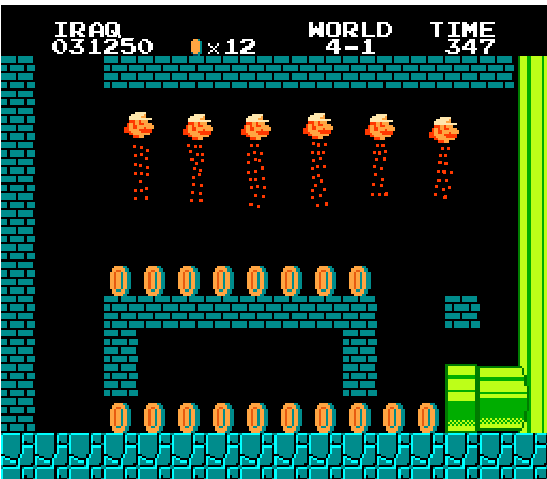
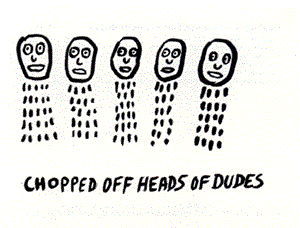
Just a few notes on Cory Arcangel's show "Welcome 2 my
The show includes a number of new hacked Nintendo game cartridges - the work that Arcangel has become known for - and a number of new works in the medium of video. In the former group are a fully interactive Ipod® programmed for the Nintendo® system and an absurdly slowed down version of Tetris®. ["Slow Tetris" is one of those instantly funny titles--you pretty much get the piece in 3 syllables. It...is...very...slow. In the existential angst category are "Japanese Racing Game," which removes the racecar and obstacles and leaves only the pulsing white highway divider receding to infinity, and "Space Invader," which subtracts all the invaders except one pitiful, descending combatant.] In the latter group are "Sans Simon," a video of Simon and Garfunkel in which the artist uses his hand to hide Simon's presence [actually it's both hands in silhouette, cast by an unseen, insane person struggling to keep Simon's face blacked out as the camera changes angles and switches from closeup to long shot of the singing duo. Always one beat behind the cut and only marginally successful as censorship, these desperate moves were hilarious--everyone in the room was laughing, probably trying to envision the guy who hated Paul (or loved Art?) to this degree.] and "Geto Boys/Beach Boys" in which videos by the two eponymous bands are played side by side creating an oddly harmonic synchronicity.Good show--highly recommended. Arcangel has another exhibit opening Saturday night, a collaboration with Paper Rad at Jeffrey Deitch called "Super Mario Movie." (The old Super Mario, I gather, as opposed to 64.) The poster is here and Alex Galloway's text is here.
[...] Arcangel is interested in keeping the possibilities of collaboration open, as well as in continuing to reach out to other cultural fields for inspiration, fusing autonomous artworks with temporary and net-based actions. The show at Team, for example, marks the launch of Dooogle.com, a search engine which only yields results about Doogie Howser, M.D. [More "no exit" angst--no matter what you punch in the same 15,900 results for Doogie come up.] Also available is a new piece of software called T.A.C. (Total Asshole Compression), a program which increases the size of any file passed through it.
Excerpts from "TEMP IS #173083.844NUTS ON YOUR NECK, or, Hacker Fashion: a Photo Essay," from the BEIGE Multimedia Gallery.
| 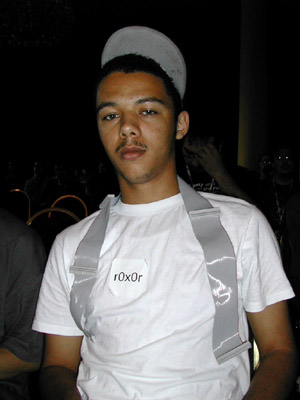 |
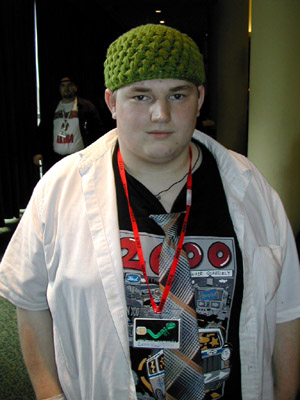 |
|
| 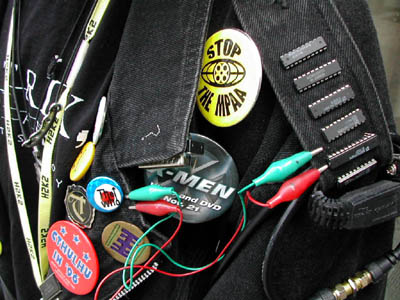 |
Images from "H2K2 - The Fourth Hackers on Planet Earth [H.O.P.E] Conference," July 12-14, 2002, New York City. Text by Paul B.Davis, photos by Cory Arcangel, fashion terminology and editing by Lauren Viera. More here.
Tools and Media: Arcangel, Maeda, Salavon, Friedman
In the comments to a previous post, twhid made a distinction between the computer as a medium and the computer as a tool, which prompted me to discuss a work by John Maeda that I believe fails as both, as contrasted with Cory Arcangel's famous Nintendo Clouds piece, which succeeds as medium, tool, and content all rolled into one. And I also talked about Tom Friedman's and Jason Salavon's work. This post is a revised, expanded version with pictures. twhid's comment:
Perhaps people are confusing these two things: are you using the computer as a tool or as the medium?And my repl(ies):
When your friend states "the resulting visual product is what matters." This means he's using the computer as a tool to a visual end. In this sense it doesn't matter, he could be using a pencil or camera or computer or eggplants to get whatever sort of visual "product" he's after.
But if one is using a computer as the MEDIUM (not simply a means to a visual end) then it seems one should have an understanding of that medium. And it's arguable that to understand a computer as a medium you really need to be able to program it.
Then of course we can start talking about using computer networks as a medium... :-)
I've been trying to keep the discussion confined to computer-made art that winds up in the "gallery discourse," or what's left of it. The use of programming in network-based art I consider a slightly different topic. As an example of the former, what is Cory Arcangel "after" in his Nintendo Clouds piece? If it's a big Barnett Newman field he probably could use eggplants (or blue squid ink) to make it. But it's more than that--it's a work where the computer is the tool, the medium, and (at least partially) the subject matter. It works on a pure visual level (a big expanse of seductive blue with wry found imagery), as a medium (the hacked cartridge as ambient video), and has something to say to hackers and non-initiates alike about the malleability of (digital) reality, through the subtraction of information from familiar game iconography. Whether someone could arrive at something that successful without a stitch of programming knowledge is one of the questions I'm asking.
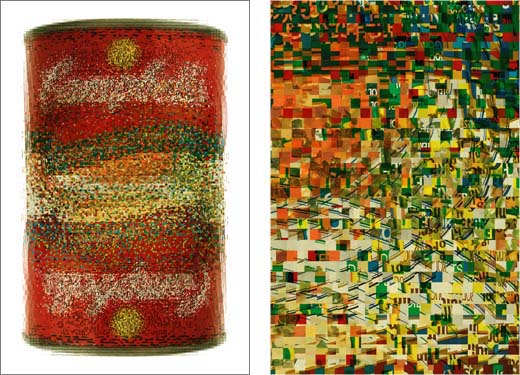
A piece that fails on all these levels is the above cibachrome print from 2002 by John Maeda, where he digitally sampled "all the Campbell's soup cans Warhol used" (as one review phrased it) and made a kind of iterative, vibrating composite. No doubt he did his own programming to realize this, but Tom Friedman, at Feature Gallery, had famously achieved a similar visual effect with a probabilistic dollar bill a couple of years before, using scissors and sheer patience. Friedman's was a well known piece in the art world, an analog design that evoked digital processes. Below is just a detail--the entire dollar is done like this, using actual cut up bucks, so the piece is about three feet long:
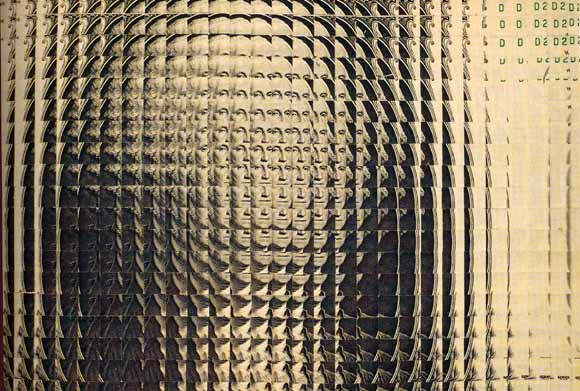
The subtle gradations between image "steps" are very trippy and disorienting, ditto seeing the familiar paper moneystuff on such a large scale. A similarly done self portrait by Friedman is online here (scroll down). As the accompanying text explains it, "Friedman dissected and re-configured 256 small, identical passport-style photographs into a large abstract self-portrait. The individual self-portraits were cut into 1/4-inch grids based on a series of nearly imperceptible 1/64-inch deviations. The 33,072 resulting squares were arranged, one by one, to create a large magnified, out-of-focus mosaic of the original image."
Maeda's soup can doesn't stretch in space but has the same hazy, micro-composite shimmer as Friedman's cut-up projects. (I don't actually consider Friedman's to be digital work, I bring it up to provide a context that previous discussion of the can has lacked.) Conceptually, and even more damning, the can is derivative of Jason Salavon, who has been making similar visual composites for years, through computer-derived averaging of like images (class pictures, Playboy Playmates, etc.) (And before Salavon, Nancy Burson...) Choosing Campbell's soup as subject matter is supposed to be "deconstructing" Warhol, one guesses, but it's a hackneyed reference. Both Salavon and Friedman know recent art history and the approximate place their work fits into it, whereas Maeda is a designer with art aspirations who admits to not following contemporary art (scroll down). Yet Maeda is showing at the London ICA and the Fondation Cartier as an artist, for reasons I don't entirely fathom (at least according to his 2002 catalog--I can't find any online reference to those shows, supposedly scheduled for 2003 and 2005, respectively).
Other Maeda work is here (I like 1, 2, and 4 but then he starts to lose me). And below is another Friedman piece that puts the can to shame. It is not out of focus; it's actual cereal boxes cut up the same way the dollar is above:
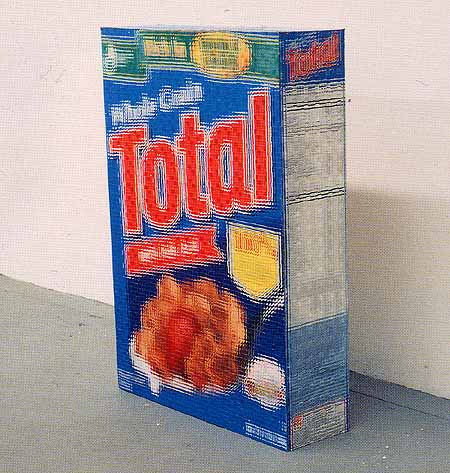
Update, December 2005: The links above to the Maeda pieces on the Cristinerose website are dead, sorry. Maeda's work did in fact get shown at the Fondation Cartier.
Update, 2011: Maeda "Food" catalog reposted as PDF
More on the coding vs artmaking question. In the comments to an earlier post, Mark contributes these thoughts about imaging and how much can or should be left to humans:
In the process of developing video systems, I've accidentally introduced a variety of bugs that create interesting and unusual visual effects. Often an understanding how the visual and the implementation are tied together has helped me to quickly understand how to correct the implementation to make the effect go away.And my reply:
It seems that going the other way -- understanding how to modify the implementation (sw, hw, algorithms) to create effects -- would give someone more "knobs," more control, more flexibility. But of course, knowing what to do with that flexibility is all the difference.
Something I don't know how to gauge is how much power is needed. I'm amazed by what artists can do with simple tools. I think I would need MatLab to draw a decent sphere.
Some people don't think drawing contributes anything to the arena of so-called advanced art (as that concept originated in the art galleries and continues in new media) while others value it far too much--e.g. the underground economy of painting that thrives in the back rooms of even so-called conceptual galleries, based on supposed authenticity of hand skill. I think the cognitive and perceptual processes associated with drawing have some role to play as art makes its transition from the vine charcoal to the 1s and 0s phase. I really can't say what or why (not succinctly anyway) other than to say that I'm enjoying continuing to draw in a field where no one can tell whether it's computer-assisted or not. (The same comments would apply to anyone with skill on a musical instrument.)
But Mark's comment makes a pretty good case for knowing some code. The problem is up to now artists and musicians have relied on technicians to develop the "knobs," and only after a product is introduced do they get to say which knobs have the potential to expand the visual/audial landscape and which are silly, soon-to-be-dated effects. Unfortunately, to date too many of the artists who code also make crappy art--and I'm talking here mostly about stuff that finds its way into galleries, as opposed to net art that is more "about" coding. The best work is happening at the low-fi end, with the BEIGE crew, say, or the music of Paul Slocum (a post about him soon). Even in Net Art, the most interesting stuff to me is often simple html, GIFs, etc.
In the comments to my previous post about whether you have to know code to make art with digital tools, Mark says "The way I read the [BEIGE] interview, the [BEIGE'rs are] interested in programming because they are interested in complete control. Do you have to stretch your own canvas to be a painter? Well, if you're tired of rectangles, perhaps."
My reply:
That's true--but some artists were tired of rectangles and made their own, oddly shaped supports. An analogy I've used is the purist artist who thinks you have to grind your own pigment to paint, either because store bought colors aren't good enough or out of some strict truth-to-materials dictate. I think that applies to John Maeda--his "if you aren't programming you aren't using the computer" rap has a whiff of the purist ascetic about it. The BEIGE'rs are a little more complicated. They're pretty much admitting that the only way they can "own" the medium is to use old computers that they can comfortably hack, so there's a built-in humility or pathos factor there. Also, they're rejecting the store-bought colors not to show their superiority to us mortals,1 but because there's something innately offensive about always having to use Microsoft Color TubesTM (or whatever) to make art. Maeda uses his dual art & programming background as a critical shield, in effect saying to artists who don't like his work, "yes, but you know nothing about the programming" and to engineers, "yes, but you know nothing about art." With the BEIGE'rs, there's no such mystification: by using the old NIntendo games as a starting point, viewers have an accessible point of entry and can intuitively "get" what they're doing.
1. Unless you're Markus Popp.
Does one have to write code to make art or music with digital tools? Two proponents of code are designer/MIT Media Lab professor John Maeda (on the hi-fi end of the digital spectrum) and the BEIGE crew (on the low end--for a manifesto see this interview). The former may be a good programmer but he's not a particularly good artist, as anyone who saw his shows at Cristinerose Gallery will attest, whereas the BEIGE-rs are good artists arguably independent of their hacking skills. The beef about using consumer software is that an engineer makes aesthetic choices for you. But there is a whole side of digital art production devoted to thwarting the programs through non-coding means---by physical interventions like damaging CDs or analog tricks such as messing with the audio or printer output or simply using the programs "wrong"--overstressing them till they start producing intriguing gobbledegook. If you limited yourself to coding you'd miss out on other fun ways to make Photoshop and MAX-MSP break down.
UPDATE: This discussion continues in these follow-up posts: 2 / 3 / 4 / 5 / 6
.
Death to the Fascist Insect That Preys on the Life of the People
The larger issues percolating around the 2004 Whitney Biennial were (A) whether the "quest for the adolescent" theme identified by the curators was real (as opposed to a thesis in search of evidence), and (B) if real, the extent to which the retreat into infantilism was (i) a response to the current pervasive terror-talk and war, (ii) a reaction to 20 years of verbal theory and no fun in art, or (iii) widespread, simultaneous opting out of participation in an art historical lineage in favor of private (outsider-ish) worlds. The pervasiveness of what Roberta Smith calls "the bedroom shows" and the rise of collectives of 20-something artists documented by Holland Cotter suggests that the trend is real. Militating against that conclusion, however, is anecdotal evidence that the curators were scouting for "young artists" out in the field, and may have skewed the survey in favor of "stuff young artists do." But then previous generations of "young artists" made ultraserious, high-toned work in their 20s, as opposed to wacky, pop-culture-driven room-filling jamborees: think Frank Stella, Gordon Matta-Clark, Eva Hesse, even Cindy Sherman & Robert Longo.
So, if we accept that this is a legitimate sociocultural trend, why the regression into the visual equivalent of baby talk? Perhaps it depends on which preschool we're talking about. The Whitney curators may very well have skimmed the most non-threatening and apolitical work out of the youthpool, while contemporaneous shows in Brooklyn and elsewhere show a "worried generation" mingling concerns about military, labor, environment, and culture-war issues with a faux-unengaged, faux-juvenile stance. Not precisely Dadaists waiting out WWI in Zurich, because overt references to current events are mixed in. I'm intrigued by James Wagner's reporting and pictures from a show I missed in DUMBO (Brooklyn) called "Death to the Fascist Insect That Preys on the Life of the People." The title is from the Symbionese Liberation Army (last invoked in the artworld in the early 90s "nihilistic" scatter art of Cady Noland), but here the grimness of Cinque De Freeze's social indictment is completely belied by the artwork on view: toys, stuffed animals, stickers, buttons, and crude thumbtacked drawings resembling an end-of-the-semester children's art show.
Based on James' photos and descriptions and what I know about some of the artists, the show looked to be an entertaining but tough-minded mix of influences: the Kenny Scharf Jetsons East Village blacklight funhouse thing, Basquiat "drawerly" cartooning, graffiti, the late 80s/early 90s slacker style, and, through manipulation of Saturday Morning sugar cereal advertising tropes, even the hardnosed, political "pictures" art of Levine, Goldstein, Prince, etc. The use of websites to document shows and present stand-alone pieces (by TAG Projects, who did the "Insect" show, but also BEIGE, Paper Rad, etc.) makes this a new animal, though. These are just the beginnings of a theory (and sorry it's so ponderous--just trying to get the thoughts down), but suddenly there's a lot of good work out there, and I'm excited by the role websites and bloggers like James are playing in documenting it, before it reaches the cooled down, institutional phase of magazine coverage and curatorial co-opting.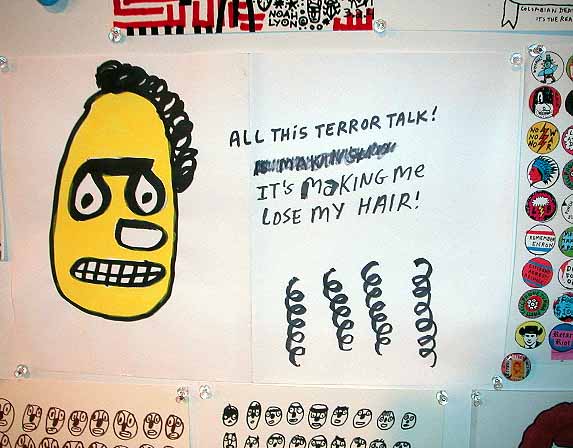
Noah Lyon, from "Death to the Fascist Insect..." Photo by James Wagner.
My ten-minute, live on the wheels mix of 8-Bit Construction Set tracks, alluded to in an earlier post, is now online. [14.28 MB .mp3] The raw materials for this Steve Reichian (or Ritchie Hawtinlike) techno-minimalist epic are the lock grooves from the "Atari side" of the disc, faded together in a continuous flow; I didn't have as much luck with the "Commodore side." Apologies to Messrs. Arcangel, Davis, Beuckmann and Bonn for this arty-fied nonsense, but it had to be done.
UPDATE:The volume trailed off slightly during the last few minutes of the recording so I tweaked it in a .wav editor and re-uploaded it. The same link above now gives you the "enhanced" version.
Three "work in progress" performances by artists from the 2004 Whitney Biennial debuted at the Kitchen last night. Tracy + The Plastics, a one-woman (virtual) band, consisted of Wynne Greenwood seated at a keyboard, playing and conversing with two prerecorded Wynne Greenwoods on DVD. The three are ostensibly sitting around their "band house" performing snippets of songs and having mock-lame arguments about the direction of their music. While frequently funny, Greenwood's passive aggressive slacker-chick persona wore thin after a while: I know this year's Whitney was about the "quest for the adolescent" but her self-absorbed conversation with the video mirror seemed trivial next to the mid-to-late 90s electro-femme performance work it somewhat resembled (e.g. Kristin Lucas, Monotrona). Alex Bag also inevitably came to mind.
Golan Levin's work was tech-intensive and nerdy (maybe it was the lab coat) but also fun and playful. He and his fellow performer Zachary Lieberman each used a combination of overhead and digital video projectors to make semi-abstract shadow-outlines (basically Rayograms) of their hands and other objects, with the overlap of the respective projector arrays creating dramatic color separation effects. The shadows in turn interacted with custom software to synesthetically translate shapes into sounds. A silhouette of a balled fist opening into a two-finger V caused a sequence of chiming musical notes to alter in mid-cascade; three fingers changed the sequence again, and so on. Clunky cut paper objects dropped onto the projector beds had their own unique audio signatures. Manning their opaque projectors like gamers at battle stations, the performers held a back & forth dialogue-cum-duel of changing silhouettes, which was exquisitely timed and quite charming.
Framing the other two performers was Cory Arcangel's "Pizza Party"--a demonstration of how to hack into the Dom1no's website and order pizza using only command line instructions. These green-on-black text-only options, which Arcangel accessed with a Perl script, lurk below Dom1no's (and every other business's) GUI, or graphic user interface, and consist of filling in "y" or "n" next to mushrooms, anchovies, thin crust, etc. and specifying a delivery address. As he walked the audience through the process on a large screen, Arcangel commented drily (but enthusiastically) on the essential uselessness of online commerce, and even greater uselessness of hacking into it, when a simple local phone call would suffice. And although he warned that failure was a possibility in his performance, his confident demeanor when he came back after the other acts told us that our pizzas had arrived.
UPDATE: "Pizza Party, a free text based software package for ordering pizza, or for throwing pizza parties" is available online here.
UPDATE 2: Somebody posted an article about security vulnerabilities in "Pizza Party," the software. No one seems to know if it was satire or not.
Notes on the 2004 Whitney Biennial
1. If you like work made with a jigsaw, painted, and stuck at right angles to the wall, this is your Biennial.
2. Started on the 2nd floor and worked up to 4. "Is this the fey, twee Biennial or just the fey, twee floor?" ("Fey": everything from Banks Violette's black, stalagmite-infested drumkit to Elizabeth Peyton's pale, perpetually red-lipped popstars; "twee": the preponderance of little craftsy cut out-y things in the show. Sensitive boys meet sensitive girls and ignore each other for their respective playworlds.)
3. Stood gaping at Assume Vivid Astro Focus' busy, businesslike post-psychedelic installation for a long time and finally said, though gritted teeth, "I don't like this."
4. Bad painting, and not in a good way: Mel Bochner's happy, colorful "word art" channelling Jessica Diamond, Kay Rosen, et al. Laura Owens' fake-zany, fake-clumsy giant tree with birds, etc.: uggh. Cameron Martin: boring!
6. Too many installations!
7. Wanted, for curatorial malpractice: Shamim Monin, Chrissie Iles, Debra Singer. Crime: Placing Cory Arcangel/BEIGE Nintendo clouds piece next to brilliantly lit mirrored room, washing out the lower right corner of the video projection. If they did this to a Barnett Newman they'd have old men with cigarettes hanging off their lower lips and romantic stubble sending them critical letters the rest of their lives.
8. Too clever by half: Golan Levin's interactive piece on the popularity of numbers. Does "3" beat "89908" for the most uses out there in the world? And what are those uses? Scroll and see! If this is a satire of the computer nerd's relentless drive to quantify everything, it's pretty good; if it's a celebration of that same tendency it's the world's most elaborate executive toy.
9. Having said all this mean stuff, the show was still fun: better cumulatively than object by object. Even mass infantile regression beats Larry Rinder's earnest, tedious 2002 effort. It helped seeing it with a large audience of toddlers, teens and bus-tour seniors: through their eyes, it was an adventure. If only that sense of awe & enthusiasm could be piped into Chelsea's dreary classist environment.
10. Best of show: the films and videos. Sue de Beer's two-channel piece, discussed here earlier, works even better in a small room than it did in Postmasters' big cube. It was great to see the Jack Goldstein loop, an undersea travelogue missing only a Film Board of Canada soundtrack and boomy male voice saying "When lava pours out of the sea mount, islands are formed..." For positive things about these and other artists, please see Sally McKay's report.
UPDATE: Here's one explanation for all the "youthful exuberance." I'm told that in setting up studio visits outside NY, the curators asked to see "young artists." That sounds like pimp talk. Hypothetical local museum director: "Are you looking for someone good?" "No, we're looking for someone young."
Beige Programming Ensemble at the Whitney; The Slowes
I missed Cory & Jamie Arcangel and the Beige crew at the Whitney last night because I had to w_rk, but fortunately Thickeye is on it with an excellent report. I like his description of the line of kids wrapped around the block for free admission night, soon to be groping in the darkened video rooms, contrasted with the image of middle age people sitting at tables in the downstairs dining room, politely listening to the Beige-rs explaining their new 8-bit iPod concept.
Beige has a music download page that I highly recommend, consisting of their vinyl releases in mp3 format. Cory also recorded several songs as The Slowes, which I am pleased to offer here. The melodies are faux-dumb and very catchy. I say faux-dumb because they're actually fairly ambitious in terms of musical reach--a lot of pop music history is integrated in them (lounge, 60s-electronica, progrock, Pink Floyd...). The lo fi-ness keeps the homages from being overt or too reverent. Here's how Cory explains them in an email (edited slightly):
yeah,...the slowes is just me. most of the melodies were written by a melody writing program i wrote called "Rudy Tardy Generator Pro"..it was a cgi script. every time you went to its web page, it generated a new song and melodies (in the slowes style, which is lotsa open roller rink kinda chords) so....... i would have the program spit out 10 melodies...i would then pick the best few, turn them into a song, and go into my bedroom and record them. i used an organ, atari, drums, + guitar////The Slowes downloads:the whole myth of the slowes that I made up was that it was this guy who sat in his basement all day and worked on his atari. his name was Rudy Tardy. This was his band. For a few years, i used Rudy Tardy to sign all my art projects...[Beige recording artist] Paul [B. Davis] to this day still Dj's under the name DJ Rudy.
"Fat Bits" [.mp3 - 1.33MB]
"Starship Izod" [.mp3 - 4.12MB]
"The Anthem" [.mp3 - 2.29MB]
"Hooked on a New Thing" (cover of 3Nuff Z'Nuff) [.mp3 - 5.2MB]
Suite: All Four Songs Above [.mp3 - 13.14MB]
Pictures from "A.B.C.", a.k.a. Another Bad Creation, a group night of video and performance curated by Cory Arcangel, at Deitch Projects, NY (last night, November 19, 2003). Featuring works created and/or found by Cory and Jamie Arcangel, BEIGE, Paper Rad, Seth Price, CELLmedia, Carly Ptak, LoVid and the shinths tour.
From the press release: "Taking its title from the early 90's teen pop band produced by Michael Bivins (of Biv10 entertainment), this night explores a style of video and performance best described as 'post cable access.' [V]ideo and live performance mash together in an almost imperceptible mix of quick cuts and poorly tracked VHS footage. Think accidental high-school videos, Salvation Army found tapes, awesome karaoke, anything originally recorded on a BETA tape, broken Nintendo games, blue screen ring tone hip-hop videos, and dance videos made with tin foil and spray paint. Th[e] night explores the side of homemade single channel video which is cheap, quick, and often embarrassing. Colliding to provide us with a clear picture of the ill fated 'home video revolution,' the foundations of A.B.C. are the celebration of the camcorder, the banality of everyday life, and a complete disregard for the medium."
Top to bottom: Carly Ptak, live video/sound/performance (a kind of transcendental meditation incantation with a spooky electro-bass pulse and the artist's face superimposed over leaves, rocks, river, and sky--rather disconcerting after a night of High Irony); LoVid, live video/sound/performance (playing their new video synth--sorry I didn't get more imagery in the shot); "Shinth," DIY performance with handmade electronic instrument built by Peter B. The Shinth tour was in the basement of Deitch's Wooster Street space; the video program ran upstairs for a continuous 90 minutes of big-screen projection. The flow of recorded videos and "pay no attention to those performers behind the curtain" live video was fairly seamless: I didn't realize till afterward that the Paper Rad performance (psychedelic nonZense literally phoned in through a stuffed talking bear telephone) was done live.
A couple more pics are here (click on thumbnails for enlarged view). More on Carly Ptak here.
Congratulations to Sue de Beer, Cory Arcangel/BEIGE, and James Siena for getting picked for the Whitney Biennial this year. Other names I appreciated seeing on the list were Erick Swenson, Yayoi Kusama, and Richard Prince, although you couldn't find a more unrelated group of artists. I had a longer post written with my thoughts on this year's lineup, but I just don't feel comfortable second-guessing the choices. Well, yes I do, to the extent I don't understand the inclusion of Robert Mangold, Paul McCarthy, Robert Longo, or Elizabeth Peyton. The institutional politics and horse-trading that go into such a high-profile project weaken it considerably, and one always wishes it would say more. Sometimes the curating's just bad: Larry Rinder might have pulled off his "high tech/primitive" duality last time if he'd picked more compelling art. Anyway, I was glad to see some people in it this year whose work I really like.
UPDATE: Someone asked to see a list of the artists; it now appears in the comments to this post.
Unfortunately I missed the opening event at Team Gallery kicking off the Beige/Paper Rad etc "SUMMEr oF HTML" tour, but photos (with funny captions) are here. The lineup included "performances and videos by: Extreme Animalz, Paper Rad, Jamie Arcangel and the Arcangels, Bitch Ass Darius, Taketo Shimada, DJ Jazzy Jess, Beige Records, Dr Doo, Insectiside, plus live HTML!!!!!! and new 'html' work by Mark River." The official tour page is here, and James Wagner has a report with more pictures on his weblog.
Revising "BitStreams" (a curatorial thought-experiment in progress)
"BitStreams" was the Whitney Museum's big "computer art" show in 2001. Like the Matthew Barney exhibit at the Guggenheim this year, it was an inexplicable hit with the general public but few artists I know (including many so-called computer artists) liked it. One problem was the curator tried to float a bunch of "discoveries" from the Bay Area and elsewhere that didn't measure up to the exacting standards of us rough, tough New Yorkers. The show suffered from a kind of mid-30-something parochialism, favoring a bunch of earnest data-crunchers the same approximate age as the curator over younger artists with a much more instinctive handle on the medium and also interesting pioneers, like Nancy Burson. And finally, it's tricky to include so-called pop culture in a so-called high art show but let's face it, there's stuff out there kicking the art world's sedentary ass. (George Bush helped word this post.) I wrote about the show here but continue to think of work that would have improved it. Some of the revisions below are tongue in cheek but most aren't:
John Klima ecosystm Joe McKay Color Game
DJ Spooky DJ Assault
Marina Rosenfeld Monotrona
Jeremy Blake videos Cory Arcangel Data Diaries and Clouds
Paintings "based on" the computer Paintings made with the computer
Lew Baldwin milkmilklemonade.net JODI % MY DESKTOP
Paul Pfeiffer Paper Rad
Jason Salavon The Top Grossing Film of All Time Jason Salavon Golem
John Simon LoVid
Planet of the Apes with sod Planet of the Apes without sod
The Spacewürm Scanner
Lutz Bacher dealercam 100 random camgirls/guys - videowall - nudity
Sally Elesby mouse drawings Kristin Lucas mousepad drawings
Jim Campbell Ambiguous Icon #5 (Running Falling) BEIGE ASCII hotdogs
Richard Devine Dynamix II
Jordan Crandall Matt & Mike Chapman
Inez Van Lamsweerde Me Kissing Vinoodh (Passionately) and/or Jon "Clone Tool" Haddock's Kent State/Vietnam backgrounds Laura Carton erased p0rn images
Jon Haddock Sims Tributes Creepy Clown
etc etc
Last night (March 6) I attended PSYCH-OUT 2K3 at Anthology Film Archives, which was part of the New York Underground Film Festival. Here's the blurb from the organizers, followed by my notes:
BEIGE and Seth Price Collective present:
Cartoons & consumer electronics in the 70s and 80s were bigger and trashier than ever and they had freaked kids out to the point of a whole generation got A.D.D. so now they are older and freak every person else out using this same old throw-away trash shit culture mind warp reversal....MESSY. You're either with us or against us.... Never fess.
PSYCH-OUT 2K3 = one night only live performance freak out featuring live music/video by the Extreme Animalz / PAPER RAD crew, NAUTICAL ALMANAC, and LOVID
In between bands there are videos by Leif GOLDBERG and Matt BRINKMAN,
Forcefield (from the archives), Devin FLYNN, MUMBLEBOY, Ray Sweeten, Andy
PULS, Seth PRICE/Michael SMITH WEB INFANTILISM, Billy Grant and Joe Grillo,
US Military Games and anon. Commodore n64 video HACKERZ. MTV circa 1990,
... LAME.
That's LoVid in my underexposed photo at the top of the post, with Kyle Lapidus standing on the right wearing a video monitor cap and Tali Hinkis, also capped, disappearing into the murk on the left. They video-projected sizzling static patterns made in real time with a sound interface that disturbs the raster scan in the guts of the TV; these minimal-but-eye-assaulting patterns towered behind them on a fifteen foot screen. Nautical Almanac and Extreme Animalz also played live, with prerecorded video accompaniment. Extreme Animalz (logo above right) is an offshoot of PAPER RAD, out of Providence RI: to get a flavor of their visual presentation, check out the dense psychedelic jungle of blinking gifs on this home page (while you're there, be sure to look at the cartoons). Nautical Almanac's video was more performance based, with the two masked artists doing eccentric body art type things (e.g., trying to climb into a cabinet wearing a leg brace) inside a ruined building at night. Think Paul McCarthy meets the Blair Witch Project. Their music, which I described here, is intense, bleeding-edge noize that synched well with the frenetic video.
In between acts a variety of short vids rolled: a lot of high-speed, insanely pigmented hallucinations, as promised, heavy on recycled/mutated kid imagery: Ronald McDonald on acid, My Little Pony in slo-mo, and some butt-awful karaoke footage. Other highlights included video art legend Michael Smith in full-on diaper mode destroying a birthday cake and blowing on a noisemaker till he got bored, an Army training film defaced with an 8-bit "PSYCH-OUT 2K3" logo (right on), and Devin Flynn's manic vision of everything in the world competing with everything else. One video really stood out, enough that I want to describe it in a separate post: a ten minute work called Assassins Ride, by Forcefield, another Providence collective which has apparently broken up recently in the (disgusted?) wake of the Whitney/Artforum/NYTimes' drive to turn them into stars. In this eerie piece, three masked figures in overcoats stand around a trash barrel fire, unmoving, while an industrial/tech score pulses. The fire flares erratically, and every so often the screen fills with glowing green light, as if some weird energy is breaking through From Beyond. The mood is hypnotic and unsettling. More later, but above is a frame I snapped off my TV at home, after I picked up a copy of the tape.
[More (or rather, better) images from this event, taken by Aya Kanai, are here.]
I've decided to follow Cory Arcangel around on the lecture circuit (not really, but this was the second talk of his I attended this week). Last night he spoke at Dorkbot-NYC, a once a month gathering that meets at Columbia U's Computer Music Center. The theme of these events is "people doing strange things with electricity." Dafna Naphtali and Liubo Borissov also gave talks. (Photos of the event are here. On the top row, Cory is the third picture, in cap and sneakers; that's me in the second pic, holding a cup.) After the speakers I was privileged to see an amazing sight, a shrine before which all electronic music fans should bow in reverence: the original synthesizer, a pre-Moog (1950s) phalanx of hardware built by RCA that literally fills a room. It's a staggering, rack mounted monolith of vintage knobs, toggle switches, patch cords, and vacuum tubes, with keypunch equipment (to enter the music score) resembling manual typewriters holding rolls of player piano paper. The behemoth hasn't been fired up in about 10 years, but it is a thing of beauty.
What follows is something I rarely do, which is dump a bunch of raw notes on the lectures. I'll be reshaping these into an argument eventually. In a nutshell, Arcangel rejects current pre packaged software and makes art at the most basic level by getting inside a Nintendo cartidge and reprogramming it; the other two artists use state of the art digital tools taken straight off the shelf, either alone or in combination with other software. Either can be valid ways of working but in this instance I prefer Arcangel's end results. Because he's a good artist, NOT because he can program.
Cory Arcangel
video game systems - first proprietary code
6502 chip is key: runs atari, commodore 64, early apple
beige recording artists (arcangel, davis, bonn, beuckman) discover it also runs nintendo games
makes political, aesthetic sense to work on that level (reprogramming chips)
you don't rely on proprietary code
you don't rely on libraries
study of the limitations of the system
learned how to crack them thru "lots of emails to swedish kids"
mario bros. - earliest, crudest nintendo game
arcangel uses EEPROM (electrically erasable programmable read-only memory) chip burner - like cd burner - to make modifications to chip
used by "home electronics nuts"
shows ambient video of mario clouds: "that's kind of like the new style"
"actual factory-soldered mario clouds"
"not a copyright violation because not a copy"
it's important to do things down in machine language
assembly language is simple: "if______/then_______"
easier than java
audience member: "so what you're saying is, you don't have to know as much, you just have to do more work"
(UPDATE: I asked Cory by email how assembly language differed from development language (see below); he replied: "Well to put it most simply, one does not have any 'objects,' or routines to inherit from. On a new computer programming language you can usually write something like 'draw red pixel at 10 pixels down and 20 pixels across on the monitor,' and it will appear. In assembly language you have machine level access to the computer therefore you have to actually write the code that will place that pixel there because aside from routines built into the hardware, you are not forced to inherit code from other people. So on a Nintendo you have to wait for the electron beam to jump to the top of the screen [happens 60 times a second], and then put values in certain registers. Then in the brief period that this electron beam is jumping you can draw some sprites to the screen at the values you poked into the microprocessor. I like it because once you get down to looking out for the TV's electron beam, you know you are getting some low level access to the idea of 'video.'")
for super mario bros clouds piece, Arcangel used text editor to identify specific clouds
i shot andy warhol based on hogan's alley
less popular shoot em up game - "pre duck hunt"
cartridge has 2 chips - one for operating system, one for graphics
couldn't do it all in graphics; hogan characters were symmetrical and andy was asymmetrical so had to go into os to find mirroring (UPDATE: Super Mario clouds and Andy Warhol are diffferent types of hacks, per Arcangel: "[Andy] is a hack of the graphics chip
although I also had to modify the program chip a little bit because I had to change the colors, and also flip some graphics around because my new characters were asymmetrical. Clouds is just a program chip hack.")
to write the code for the chip, Arcangel uses a 6502 assembler running on a mac; the assembler's code is MPW (Macintosh Programmer's Workshop), a game development language, which runs on top of unix (UPDATE from Cory by email: "An assembler is a program that takes assembly language
[which is a kind of short hand] and turns it into machine code [which can be burned onto a chip]. My assembler happens to be a port of an old UNIX program that runs under MPW on a Macintosh. There are many different assemblers for many different platforms so the idea of it being MPW and from UNIX does not really matter. Sometimes I use an assembler that runs on DOS, and NOW I use one that runs on OSX called nesasm. Usually I would not get into that, but I suppose someone asked me a question and I had to explain exactly what I was using... Actually now I am trying to not use an assembler at all and just write the compiled machine code by hand in 1s and 0s. Just for a challenge. This is because Joe Beuckman and I kinda came up with the idea to be a
real BEIGE members one has to write in 1s and 0s.")
cartridge hacks done in rom, then tested in emulator (UPDATE: as Cory explained later by email: "an emulator is another piece of software that runs a compiled
program for the system it is emulating. They are mainly used so people can play games they grew up on, using modern computers. So for example with a Nintendo emulator, I can play super mario brothers on my MAC." His preferred one is RockNES)
"harder to reverse engineer than engineer" - one audience member takes issue
other project: collaboration with paper rad (Providence RI collective)
telling story with projection in background
(like puppet show?) no, 8-bit version of machinima
one more project: rave videos
writing programs with the mario software (demonstrates blinking geometric grids made from changing background colors - a high speed, better version of jeremy blake's early grids imho) taking advantage of mario's ability to sync up with the tv raster at 60 lines per second refresh rate, which is twice as fast as video (32 lines per second)
tag line: "twice the psychedelia"
audience member: will you ever work with game boys?
"game boy irks me"
Dafna Naphtali
"higher end audio"
uses MAXMSP music software
performance oriented
processing audio live
digital chamber-punk ensemble
Liubo Borissov
video synthesis from music
"making fire dance"
synthesized tabla drum - jerkily "dancing" flames (i did not like this - too new age)
music program used: reactor - modular synthesizer like maxmsp
edits "standard fire synthesis effect" in aftereffects, using parameters based on sound.
"communication" - looks like advanced early 90s rave video
ballet dancer with superimposed abstract painting
uses poser program for video of dancer
poser creates transitions between one pose (motion capture) and another
traces of shadow of dancer correspond to sound data
uses studio artist paint program for blue painting overlaying dancer
g-force moderates between studio artist and sound
poser option: "render as painting"
example of mapping sound to image: bass to physical size
Tonight I attended an evening of electronic/noise performances, organized by LoVid at Gale-Martin Fine Art in lower Chelsea. The theme was "artists working with homemade electronics and electronic signals," and the vibe lay somewhere between that photo of Microsoft employees circa 1975, fashionwise, and a Survival Research Labs performance in 1986, intensity level-wise.
Check out these designs showing you how to make the entire Pokémon menagerie out of beads. The artist is Jason. (Above: Magneton.) The drawings are great, lo-fi patternmaking, and the site is a fine example of Dirt Style design. While the above image's suggestion of computer pixelation is largely unintentional, artist/musician/programmer Joe Beuckman pushes the connection explicitly in his beadworks. The image below, captioned "Karate Kicking Ensues," is from a series based on scenes from Datasoft Presents Bruce Lee, programmed by Ron J Fortier, 1983 (graphic design by Kelly Day).
Thoughts on Monotrona, Cory Arcangel, and the return of Old School Vid Games. I've never been much of a player of videogames but I love the distinctive, cheap-synth-meets-sped-up-player-piano sound of the early consoles. There's something beautiful and stupid and perfectly reductive about those adrenaline-filled melodies, as urgent in their own way as Ramones songs. In 1983 Haruomi Hosono, of the Japanese technopop outfit Yellow Magic Orchestra, released an LP of game ditties on the Alfa label; the genius of his Videogame Music was that he didn't "interpret" the tunes but presented them straight up (according to this Hosono fan page, VGM was the first of what went on to become an established genre in Japan). Of all the tracks on the album--"Xevious," "Bosconian," "Pac-Man," "Phozon," "Mappy," "Libble Rabble," "Pole Position," "New Rally-X," "Dig Dug," and "Galaga"--only the last got some YMO-style musical embellishment; everything else was treated as found sound. I bought the album in the '80s and listened to it with the proper degree of quasi-ethnographic disinterest, as if it were a Harry Smith collection of folk ballads, but also just plain enjoyed it. Not only did the anonymous composers compress the entire musical spectrum--classical, pop, show tunes--into the smallest number of bytes, they wrote some damn catchy tunes ("Dig Dug" is still stuck in my head).
Videogame bleeps and sniggles were an important component of the early '80s "electro" scene, which was primarily urban hiphop and synthfunk in the Man Parrish/Afrika Bambaataa/Roger Troutman mold (see David Toop's A-Z of Electro for a definitive rundown). Pop culture has been revisiting that scene for a few years now in connection with the '80s nostalgia boom, and videogame sights and sounds are once again in the air. In this post I discuss two careers that are somewhat tangential to the taste-cycle, but nevertheless informed and uplifted by it. Monotrona is a post-feminist, posthuman musician/performance artist who uses old-school electronic gadgets in her act: her new CD, Hawkeye and Firebird, prominently features ancient Commodore 64 game sounds. Cory Arcangel is a computer artist associated with Beige Records, the definitive electro-slacker (but not really) combine.
I first heard Monotrona on the Stork Club on WFMU-FM (a sadly missed live music show), around '97 or '98, performing "Joey, a Mechanical Boy,” which was described as the "fourth in a 14-section work called the 'Fourteen Imitations of Man.'" The story--told in music and dialogue, all performed by the artist using a variety of accents, vocoderlike filters, etc.--was extremely weird. Joey is an ectopically-spawned robot child who goes to work for NASA. His mother, in a ridiculous Chicago accent, tries to reach him on the phone and is headed off by the "Dark Technical Force," a gnostic demiurge that has a strange hold over Joey. Meanwhile, two shadowy government operatives discuss a rogue scientific scheme to create a ManWoman. The piezoelectric puppet show includes some really beautiful songs in the Chrome/Suicide/Throbbing Gristle postpunk vein, performed with buzzy, distorted keyboards. After the performance, Stork described Monotrona's equipment for listeners as "a mountain of unpatented cheap toy electronics adapted for her use--an indescribable array of electronics centered around a Casio machine, using light sabres, pistols, all sorts of mixers, and an oscillating device that looks like a little recipe box with two joysticks coming out of it..." [added 3/24/04: my cassette tape of the event: 36 min, 33.6MB]
Clearly Monotrona's act is visual as well as sound-based, but I've yet to see her live. Searching around the Internet I found a number of baffled and/or dismissive reviews of her stage show. Nevertheless, as a radio musical "Joey" was brilliant and I've been eagerly awaiting a followup. It finally arrived last month in the form of Hawkeye and Firebird, an 8-song, 21 minute CD on Menlo Park. Evidently her "14 Imitations" cosmology has morphed into a gesamtkunstwerk called "Superbeings," and the CD's title characters are two more personae in that scheme (I note that Joey is still on the list, too). Some listeners may be put off that she sings all the songs in the pidgin-English, little-girl voice of Hawkeye, a "Korean superhero" who flies around the world in her airplane accompanied by Firebird, a legless robot slave. ("People awound the world are afwaid/Don't worry people, we will fight and save the day!") The vocal conceit works well on about half the songs, and the music is consistently arresting. She integrates game tunes from the Commodore 64 ("Hotrod," "Monty on the Run," "Sanxion," "Crazy Commets") into the songs sometimes as the primary melody (I think), other times as effects and fills. All of the tracks have the breakneck speed and delicious brevity of the best game music, and there's at least one Gary Numan reference.
The Commodore 64 also appears on The 8-Bit Construction Set LP, released in 2000 by the musical ensemble of the same name: in addition to Cory Arcangel, the group consists of Paul B. Davis, Joe Beuckman and Joe Bonn. This unusual record is marketed as a "dj tool" that includes samples and lock grooves for use in live performances. "8-bit" refers to the very low memory computers first introduced in the '70s and early '80s, including the Atari line, much fetishized by geeks. Meticulously organized, The 8-Bit Construction Set has an "Atari side" and a "C64 side"; each includes samples and "scratch tones" taken from the respective computers (including sound clips from ads used to sell them back in the day), about ten locked grooves with beats and simple loops played on the machines, an original 2 or 3 minute composition ("Saucemaster" on the Atari side and "Dollars" on the C64 side), and a track of actual data that can be recorded on audiocassette tape and fed into the appropriate computer (these sound like fax machine tones until you translate them). Highlights include a promo of Alan Alda hawking the Atari to nervous first-time users, and the two aforementioned original tracks by the group, which are slammin' Detroit-style electro (wish there were more of them). With two copies of the record you can amuse your friends and pets by performing long, trippy Steve Reich compositions using the lock grooves and a fader; I'm not embarrassed to admit I tried it.
The DIY aesthetic also infuses Arcangel's visual work, particularly what he calls his "Nintendo cartridge hacks." On his website, he describes in mind-shattering detail his process of disassembling game cartridges and adding or subtracting characters and backgrounds. This compulsion to educate is part of the Beige Records schtick, as explained in this New York Times article:
The [8-Bit] stage show was a testimony to nerdiness. It wasn't enough for the group simply to play dance music on old Atari and Commodore 8-bit computers and show homemade "Star Trek"-like films. It continually stopped its show to announce the type of computer being used, how much memory it had, its assembly language and other technical minutiae. This was an attempt not just to show how difficult sophisticated electronic dance is to make on such retro technology, but also to savor the moment in the limelight that the group members' cumulative hours of computer reconstruction, programming and yard- sale searching had bought them.
For his piece I Shot Andy Warhol, Arcangel took apart a cartridge called Hogan's Alley, a fairly elementary target-shooting program, and substituted new characters on a chip of his own making. The object of the hacked game--and it really is this simple--is to aim a plastic pistol at the screen and hit the Andy Warhol icon whenever it pops up in the alley, while avoiding hitting the Pope, Colonel Sanders, and Flavor Flav icons. The game ends when you've made 10 misses (including erroneous celebrity kills). In another part of the game you take potshots at falling Campbell's soup cans, and flouting the laws of physics, make them bounce upwards through an open window.
Elsewhere on this page I've dissed art-smart art using videogames, and still think the idea of blowing apart a Foucault text in an arcade-style shoot-em-up is pretentious. At first I was annoyed by the concept of I Shot Andy Warhol for this reason. Oh, no, not him again. But after playing the damn thing at Eyebeam Atelier (and I must proudly say, advancing the TOP SCORE on all 3 subgames) I have to say it's so focking stoopid it's OK. It is what it is: an opportunity to be vicariously transgendered (if you're a guy) and sociopathically kill an important-but-overhyped art world figure again and again. (My only two "misses" were plugging Colonel Sanders twice; that was pretty fun too).
On my "miscellaneous page" I've critiqued some anime-style drawings by Krystal Ishida, an artist based in the UK who I discovered surfing around the net. Her work has enthusiasm and punch, and I don't care if she's still in the learning stages: she works harder than a lot of mature artists I know. Also, I'm interested in what makes a good web drawing, and in the post I discuss some of the aesthetics of using low-fi vs. "upgraded" software.
Also, on my technodiary page I discuss a recent release by Beige Records artist Paul B. Davis.
Two works by Cory Arcangel:
Carnivore: "This project is a standalone home TV unit which connects via Ethernet to a packet sniffer and counts the number of times the phrase "boo yaa tribe" is passed through the network displaying the result on a television screen [note: the television is woodgrain!]. It is done in collaboration with RSG and made entirely out of discarded computers and salvation army bought equipment."
Landscape Study #4: "Essentially I decided to create a background for a game that doesn't exist about my home-town of Buffalo, New York. To accomplish this feat I took 360 degree landscape photographs of a neighborhood in Buffalo and scanned them into a computer. I then formatted them to fit the graphics format of the the Nintendo Entertainment System which because of its severe hardware limitations can only hold 8K of graphics. Once formatted for the Nintendo, I wrote a program that would scroll the graphics [remember Mario?] and my partner Paul Davis wrote a sound track. I then melted the computer chips off a Super Mario cartridge and replaced them with chips I manufactured." (This piece is currently on view at Bitforms gallery in NYC.)
Another Arcangel project (with others): A vinyl record called 8-bit Construction Set ("Atari vs. Commodore").
Interesting interview with Arcangel, Davis, and other artists on the Beige label expressing their "fat bits" and "post-data" philosophy of art/music, and dissing Oval's Markus Popp for using pre-programmed software.
Much of this material on Arcangel, et al, can be accessed through this page hosted by a major museum.
Days 6-7 Paris
I got back to New York yesterday. My last two days in France consisted of pleasant but fairly conventional tourism. Saturday Dave and I wandered around Montmartre, which is the "artist's district" one sees recreated on sound stages in An American in Paris, now largely a souvenir dispensary. It's still a gorgeous neighborhood of narrow angular streets, built on a hillside topped by the striking, mosque-like Sacre Couer church; historical markers tell you where famous artists and writers once lived. We strolled (actually elbowed our way) around the "artist's plaza," watching tourists shelling out money for street portraits and bad Impressionist knockoffs. The waiter at a cafe there advised me to keep my backpack under my seat. On the steps of Sacre Couer, street vendors with plastic buckets full of soft drinks and bottled water scatter like cockroaches every hour or so to avoid the gendarmes, who make perfunctory confiscations.
Sunday Dave, Trish, and I went to the Louvre, which has been much remodeled since I visited ten years ago. The highlight of my last trip, the collection of outrageous chimerical statues looted--sorry, taken for safekeeping--from Mesopotamia, was unfortunately closed, but the Sackler galleries of ancient Iranian reliefs and palace architecture, refurbished in 1997, are breathtaking. A group of half-men/half-lions, carved in profile into beige and turquoise relief tiles, is as sparingly and tastefully installed as a Donald Judd show, blending ancient and modern sensibilities. In the German painting section, I spent some time pondering Cranach the Elder's weird painting The Age of Silver. In this Edenic scene, all the figures are nude; on the left hand side of the panel, lovely women (for Cranach) cuddle with exquisite, happy looking children, while in the center and right a group of men beat the crap out of each other with wooden staffs. Is the message really as simple as "women good, men bad"? Was Cranach the Andrea Dworkin of his day?
After two weeks abroad, I was surprisingly happy to come back to New York. On the airport bus, everyone was bickering, but at least in wasn't in mandatory French! (I know, my US-centrism is showing.) Also, dirty as our subway cars are, they're so much better designed than Parisian ones. In Paris, half the car space is taken up with a few rows of fore-and-aft-facing seats, allowing exactly 16 people to enjoy a quaint, 19th Century style ride in the car's center while the rabble stands cheek to jowl at either end. Quel merde!

